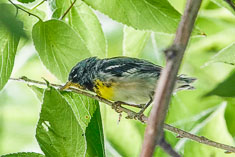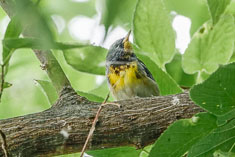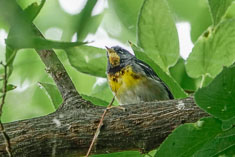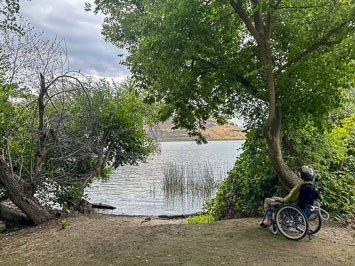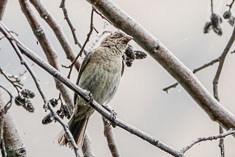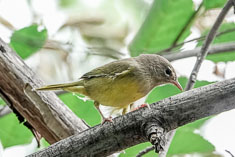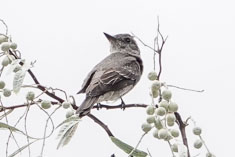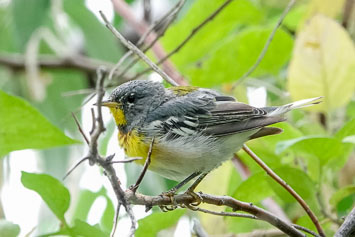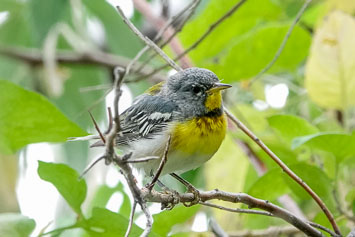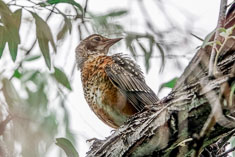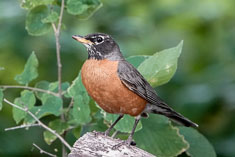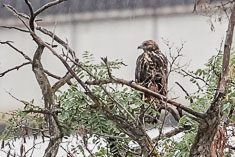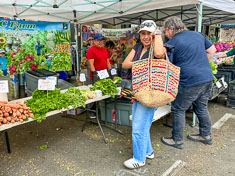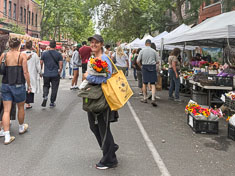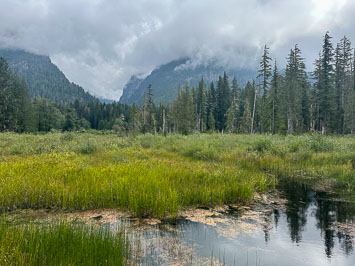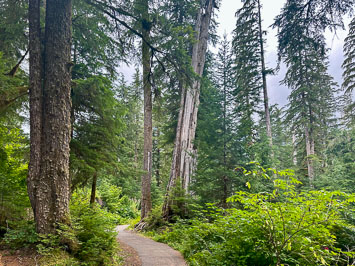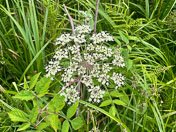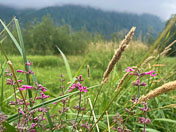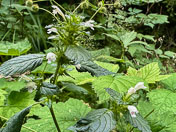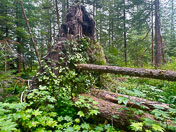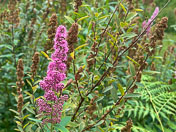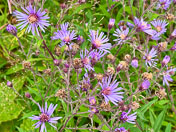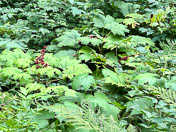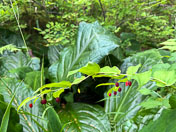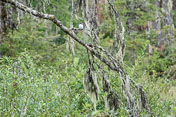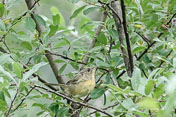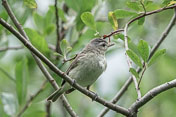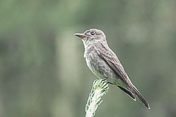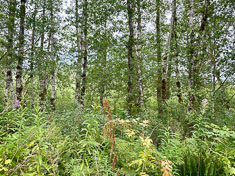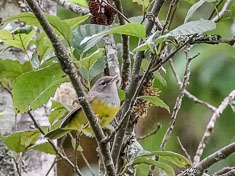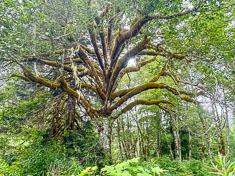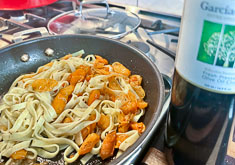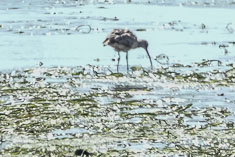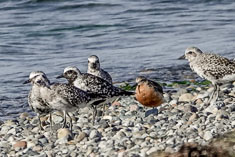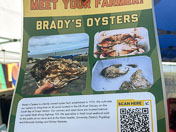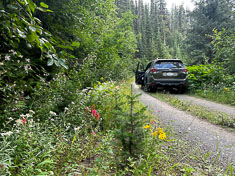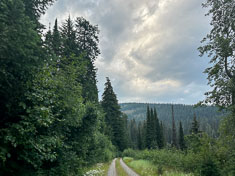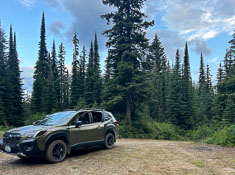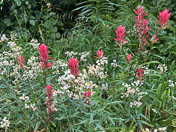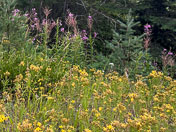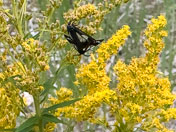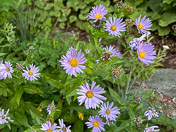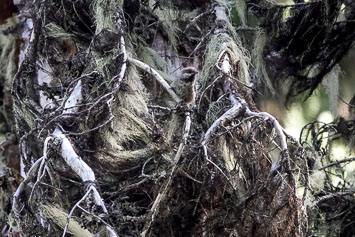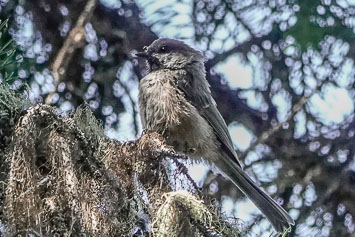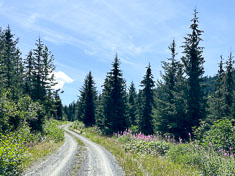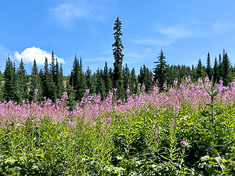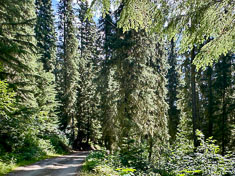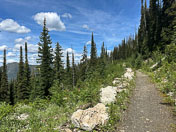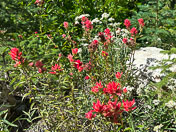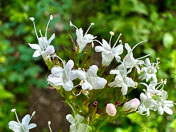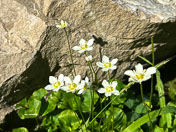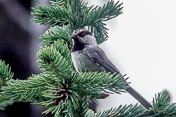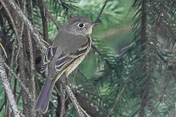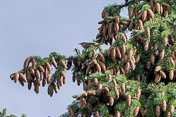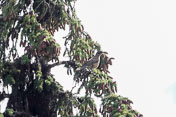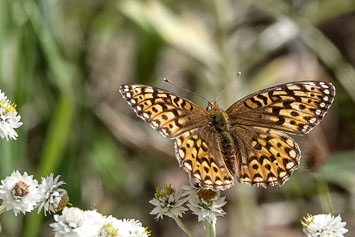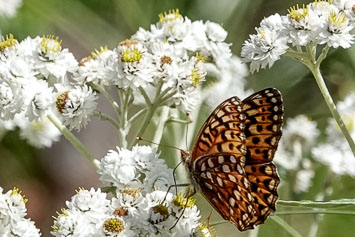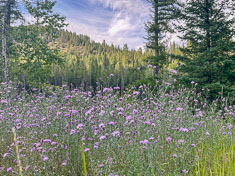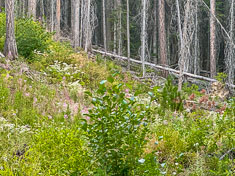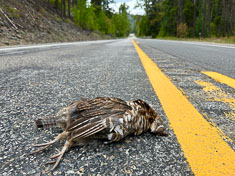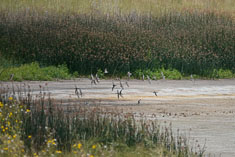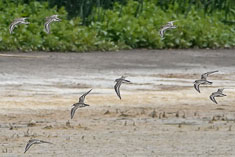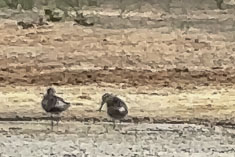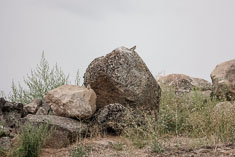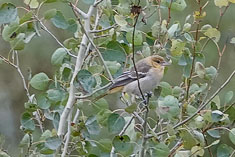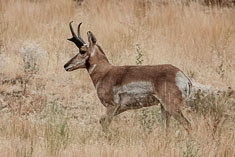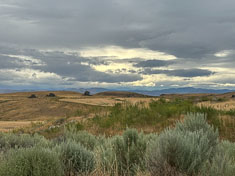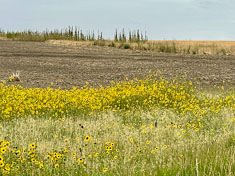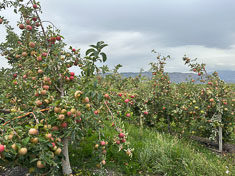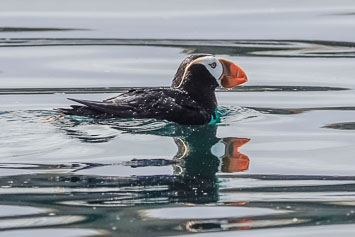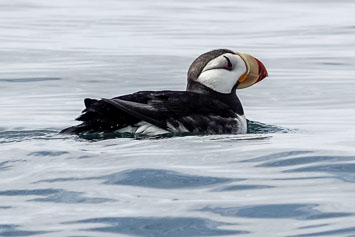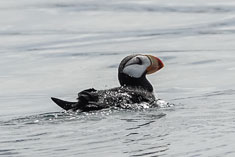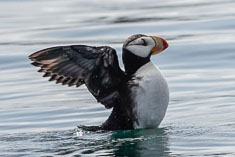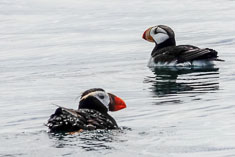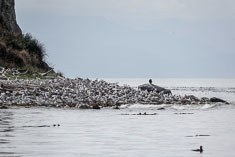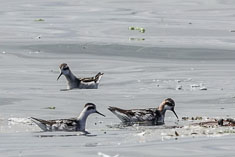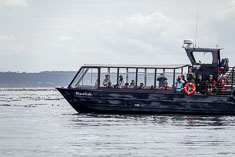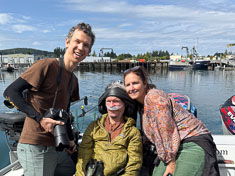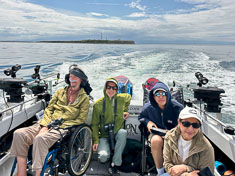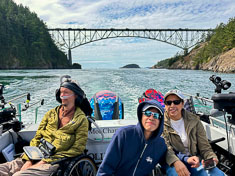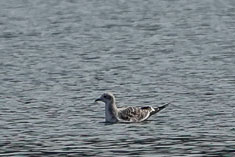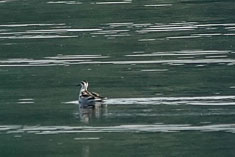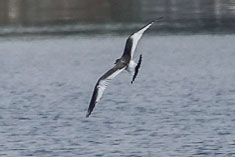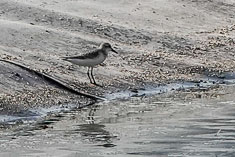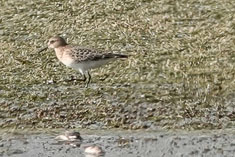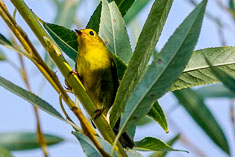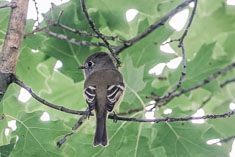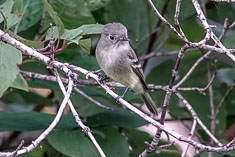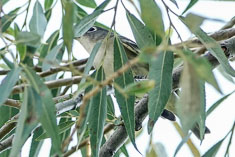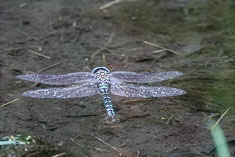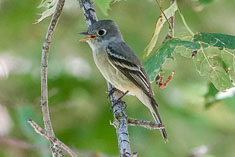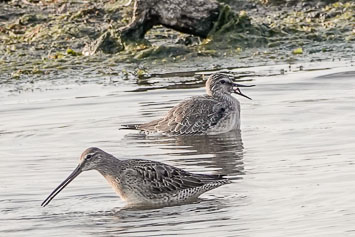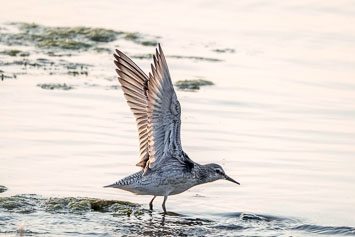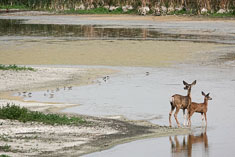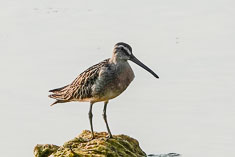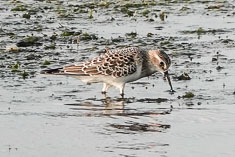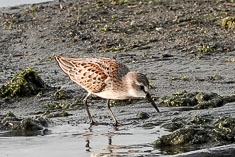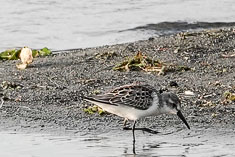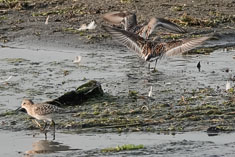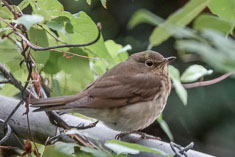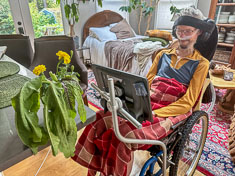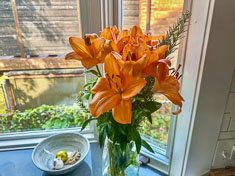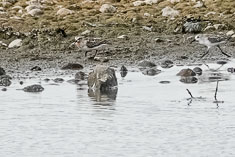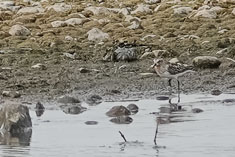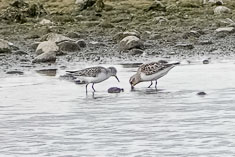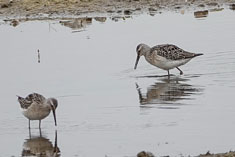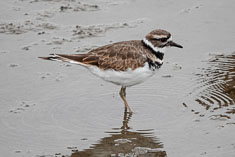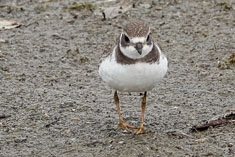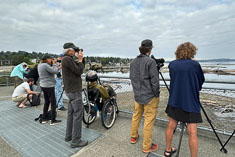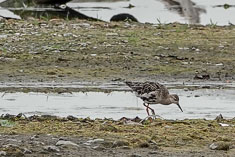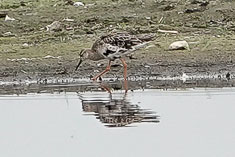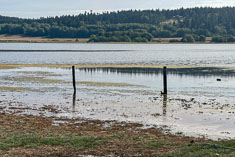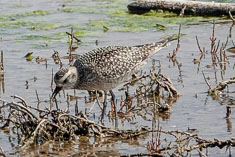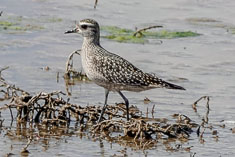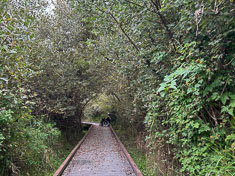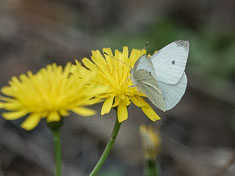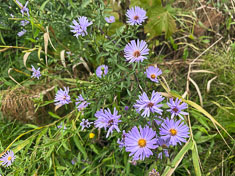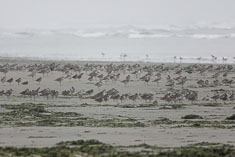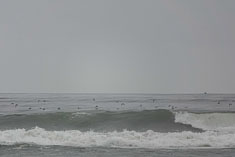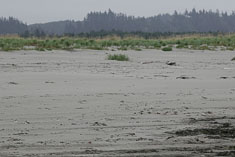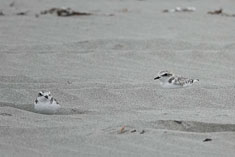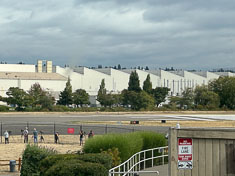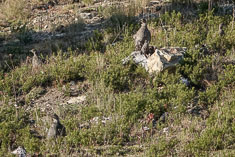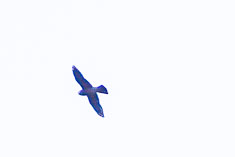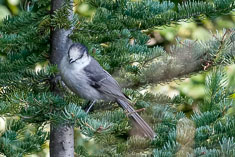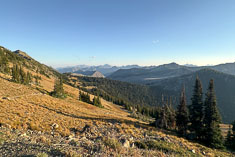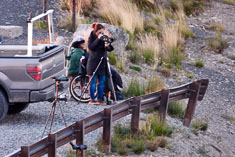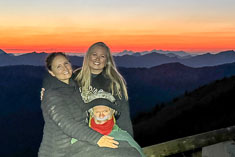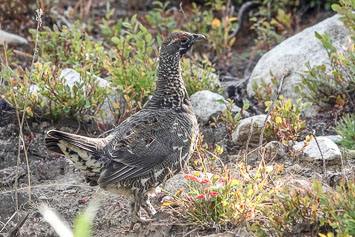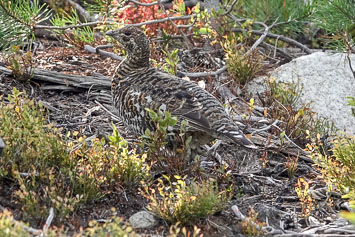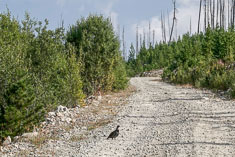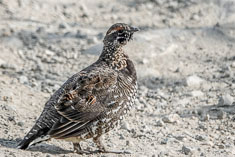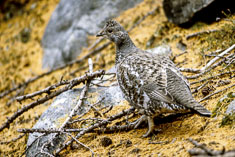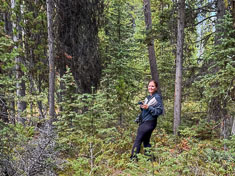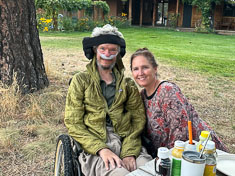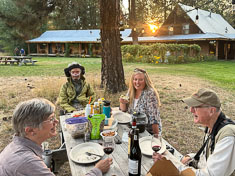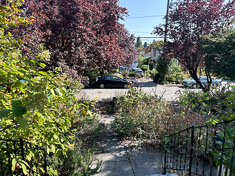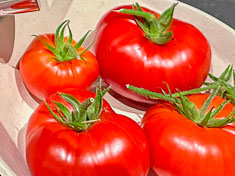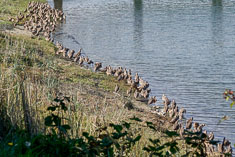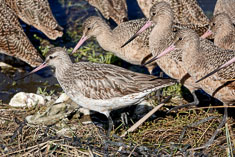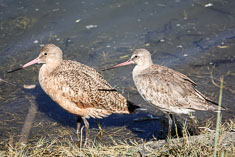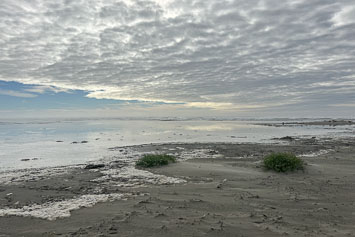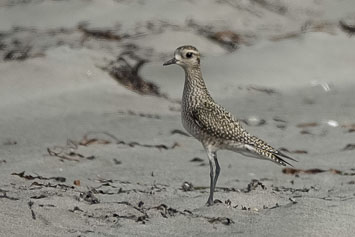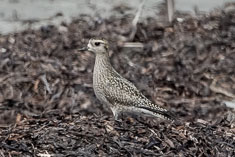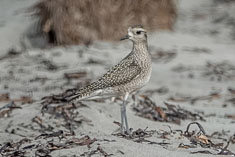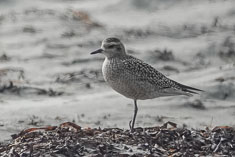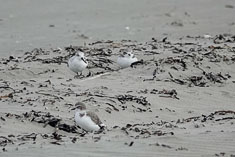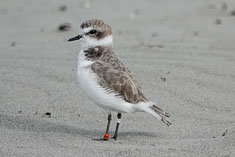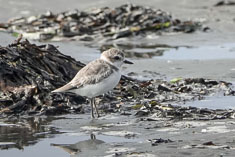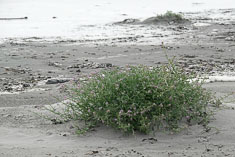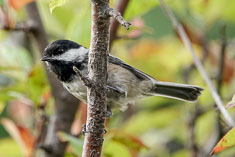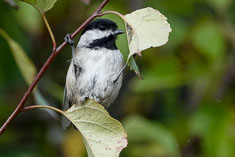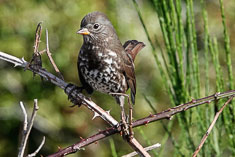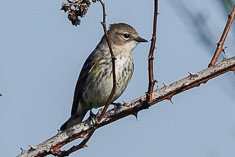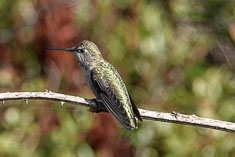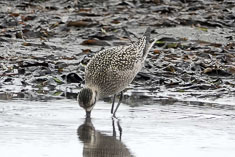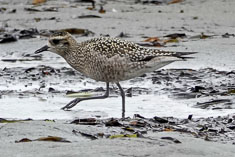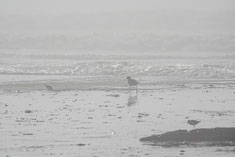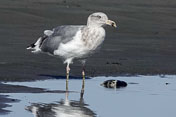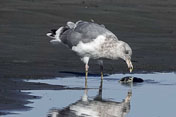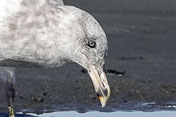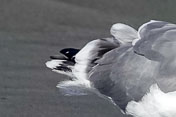7/5/2025 News (link to here)
While Darchelle met Ellen and family at PCC for lunch I called Mom. Unlike the last time we tried to connect on Teams, almost two weeks ago now, today my voice was strong enough for her to hear me and we talked for over an hour. The bugs are mostly gone so she's been having lunch outside on the porch (or patio, I wasn't sure which) from time to time. The garden, and her pots on the back deck, aren't producing any vegetables yet but she has lots of flowers - peonies wrapping up, roses along the driveway at their peak and Shasta Daisies coming soon. A bear broke into the two nest boxes at the edge of the field in which chickadees and Tree Swallows had begun to nest, presumably the same bear that got a family of bluebirds in one of Rick's boxes down in the lower field. Mom has been taking in the bird feeders at night to keep it from getting into those as well. The new septic tank is all installed, replacing for $7800 the cesspool which has been rotting near the upper end of Mom's old flower garden since I was a child.
Speaking of lunch on the porch, I asked about Mom's neighbor across the street, also 97, also named Alice, who often walks over to say hi if she sees Mom out. She and Alice Proctor, while never close friends, have been summer neighbors for most of their lives. The Proctor's three-story shingled house was built around 1907 by a woman named Buttman who first learned about Jackson from Mom's great-grandparents on board a ship while crossing the Atlantic. Alice's grandparents bought it in the 1920's when they retired from keeping the White Mountain Inn 500 feet away across the field. According to Mom the house was built as a summer home (a dilatory domicile in the high society language of the Social Register +) and has never been winterized. Alice's parents Will and Louise moved in upon their retirement from running the White Mountain Inn sometime around 1950 but as long as I knew them, they migrated south to Florida for the winter. Alice migrates south to the West Side Road, only a twenty minute drive even at her age.
It was Will who taught me to kill trout. Seeing me walk across his front yard one day carrying a forked alder stick with several six inch Brook Trout dangling from it, he called me over to admire my catch. When he realized that the fish were still alive he admonished me, "You need to kill them so they don't suffer." He showed me how to stick my thumb inside the trout's mouth and snap its head back. "Always kill your trout" he told me in his gruff voice, and after that I always did. A few years later, when I was probably in seventh or eighth grade, he gave me some more advice. "When you're deciding what to do for a living, make sure that it's something you're good at. You need to be the best at whatever you do." At the time, living in rural New Hampshire and soon to start high school, that advice felt almost timely. When I finally did decide on a career nearly 20 years laer, it was my wife's advice that drove my decision. "If you're going to spend all your time on that computer, you need to figure out how to get paid for it.", she told me. I did and I was good, if not the best, at it. But I digress.
As we usually do, Mom and I talked about the books we've been reading. We favor similar genres, mysteries set in interesting locations, and historical fiction. Both of the mystery series which Darchelle and I have enjoyed over the past several years, the Inspector Gamache novels by Louise Penny and the Mike Bowditch mysteries by Paul Doiron, were recommendations from Mom. Today she had another recommendation, relayed from Sarah: the Irish Village Mysteries by Carlene O'Connor. I read the first chapter of the first one, Murder in an Irish Village, on Libby + and found it colorful, engaging and fast-paced, but perhaps a little too reminiscent of a romance novel for my taste. Pretty heavy on the Irish too but I checked out the audiobook anyhow to get Darchelle's take on it.
Later...Darchelle loved the story, the setting, the characters and above all, the reader's Irish accent, so we have found our next mystery series.
While Darchelle met Ellen and family at PCC for lunch I called Mom. Unlike the last time we tried to connect on Teams, almost two weeks ago now, today my voice was strong enough for her to hear me and we talked for over an hour. The bugs are mostly gone so she's been having lunch outside on the porch (or patio, I wasn't sure which) from time to time. The garden, and her pots on the back deck, aren't producing any vegetables yet but she has lots of flowers - peonies wrapping up, roses along the driveway at their peak and Shasta Daisies coming soon. A bear broke into the two nest boxes at the edge of the field in which chickadees and Tree Swallows had begun to nest, presumably the same bear that got a family of bluebirds in one of Rick's boxes down in the lower field. Mom has been taking in the bird feeders at night to keep it from getting into those as well. The new septic tank is all installed, replacing for $7800 the cesspool which has been rotting near the upper end of Mom's old flower garden since I was a child.
Speaking of lunch on the porch, I asked about Mom's neighbor across the street, also 97, also named Alice, who often walks over to say hi if she sees Mom out. She and Alice Proctor, while never close friends, have been summer neighbors for most of their lives. The Proctor's three-story shingled house was built around 1907 by a woman named Buttman who first learned about Jackson from Mom's great-grandparents on board a ship while crossing the Atlantic. Alice's grandparents bought it in the 1920's when they retired from keeping the White Mountain Inn 500 feet away across the field. According to Mom the house was built as a summer home (a dilatory domicile in the high society language of the Social Register +) and has never been winterized. Alice's parents Will and Louise moved in upon their retirement from running the White Mountain Inn sometime around 1950 but as long as I knew them, they migrated south to Florida for the winter. Alice migrates south to the West Side Road, only a twenty minute drive even at her age.
It was Will who taught me to kill trout. Seeing me walk across his front yard one day carrying a forked alder stick with several six inch Brook Trout dangling from it, he called me over to admire my catch. When he realized that the fish were still alive he admonished me, "You need to kill them so they don't suffer." He showed me how to stick my thumb inside the trout's mouth and snap its head back. "Always kill your trout" he told me in his gruff voice, and after that I always did. A few years later, when I was probably in seventh or eighth grade, he gave me some more advice. "When you're deciding what to do for a living, make sure that it's something you're good at. You need to be the best at whatever you do." At the time, living in rural New Hampshire and soon to start high school, that advice felt almost timely. When I finally did decide on a career nearly 20 years laer, it was my wife's advice that drove my decision. "If you're going to spend all your time on that computer, you need to figure out how to get paid for it.", she told me. I did and I was good, if not the best, at it. But I digress.
As we usually do, Mom and I talked about the books we've been reading. We favor similar genres, mysteries set in interesting locations, and historical fiction. Both of the mystery series which Darchelle and I have enjoyed over the past several years, the Inspector Gamache novels by Louise Penny and the Mike Bowditch mysteries by Paul Doiron, were recommendations from Mom. Today she had another recommendation, relayed from Sarah: the Irish Village Mysteries by Carlene O'Connor. I read the first chapter of the first one, Murder in an Irish Village, on Libby + and found it colorful, engaging and fast-paced, but perhaps a little too reminiscent of a romance novel for my taste. Pretty heavy on the Irish too but I checked out the audiobook anyhow to get Darchelle's take on it.
Later...Darchelle loved the story, the setting, the characters and above all, the reader's Irish accent, so we have found our next mystery series.
7/25/2025 Mom fell (link to here)
My 97 year-old mother fell two days ago. As falls go it was minor but when she was complaining of back pain yesterday afternoon, she agreed to Dee's suggestion that they go down to the hospital to have her checked out. That's when I heard about it. Someone from the emergency room called me to ask for my consent to treat her, but they didn't know what was wrong. I found it a little alarming that Mom apparently couldn't herself give consent to be treated but the person on the phone promised to call back within an hour or so with more information, so we agreed to wait.
Darchelle and I were on our way to Walla Walla for the weekend so we stopped at the next gas station, which happened to be the cheap place in Thorp with the prominent sign proclaiming in big red letters "UNLEADED 3.84", and tried to contact Sarah in Sweden. She didn't answer, not too surprising considering it was the middle of the night there, but Darchelle was pretty sure she'd been able to leave a message. She sent a quick email too and we continued on our way, passing the remaining three hours of the drive in conversation with Susan Pellandini about her new job prospects. I eavesdropped, whispered my two cents worth of advice now and then (my voice was weaker than usual) and watched the temperature display on the dashboard. I was rooting for it to break 100 but it only reached 99, in Richland, or maybe it was Kennewick; I have trouble remembering which is which.
At any rate by then we'd heard back from both the hospital and Dee that Mom was OK, just a bit sore, and would be going home shortly with a fistful of Tylenol. This morning we heard from Sarah that the Tylenol hadn't done the trick and Mom had not had a good night. By the time I talked with Mom on the phone after lunch, she and Dee had returned to the hospital, confirmed that Mom's discomfort while breathing was not caused by Pneumothorax, and had prevailed on the nursing staff to arm her with Tylenol+Codeine for the next few days. Mom sounded better on the phone and she was able to hear me well enough that we had our best phone conversation in months.
I also enjoyed catching up with Sarah and Roger on FaceTime once we got the serious (albeit good) news about Mom out of the way. It's hot and humid in Sweden so they've been swimming several times a day but not in the evening, when the mosquitoes get bad. They missed most of the chanterelles, which fruited while they were at the magic conference in Italy, but were headed into the woods this afternoon to harvest blueberries, which are just coming on. The potatoes in their garden were coming on too and they'd just enjoyed the first of their traditional midsummer meals of new potatoes and pickled herring when wild boars came through during the night and plowed up the rest of their potato patch. Roger was philosophical about it; after all, he'd only planted the potatoes there because the boars had visited in the spring and plowed up the lawn. I suggested he procure a rifle and supplement what's left of their potato crop with some roast pork.
It is a bit ironic that my best conversations with family happen as a result of Mom's falls.
My 97 year-old mother fell two days ago. As falls go it was minor but when she was complaining of back pain yesterday afternoon, she agreed to Dee's suggestion that they go down to the hospital to have her checked out. That's when I heard about it. Someone from the emergency room called me to ask for my consent to treat her, but they didn't know what was wrong. I found it a little alarming that Mom apparently couldn't herself give consent to be treated but the person on the phone promised to call back within an hour or so with more information, so we agreed to wait.
Darchelle and I were on our way to Walla Walla for the weekend so we stopped at the next gas station, which happened to be the cheap place in Thorp with the prominent sign proclaiming in big red letters "UNLEADED 3.84", and tried to contact Sarah in Sweden. She didn't answer, not too surprising considering it was the middle of the night there, but Darchelle was pretty sure she'd been able to leave a message. She sent a quick email too and we continued on our way, passing the remaining three hours of the drive in conversation with Susan Pellandini about her new job prospects. I eavesdropped, whispered my two cents worth of advice now and then (my voice was weaker than usual) and watched the temperature display on the dashboard. I was rooting for it to break 100 but it only reached 99, in Richland, or maybe it was Kennewick; I have trouble remembering which is which.
At any rate by then we'd heard back from both the hospital and Dee that Mom was OK, just a bit sore, and would be going home shortly with a fistful of Tylenol. This morning we heard from Sarah that the Tylenol hadn't done the trick and Mom had not had a good night. By the time I talked with Mom on the phone after lunch, she and Dee had returned to the hospital, confirmed that Mom's discomfort while breathing was not caused by Pneumothorax, and had prevailed on the nursing staff to arm her with Tylenol+Codeine for the next few days. Mom sounded better on the phone and she was able to hear me well enough that we had our best phone conversation in months.
I also enjoyed catching up with Sarah and Roger on FaceTime once we got the serious (albeit good) news about Mom out of the way. It's hot and humid in Sweden so they've been swimming several times a day but not in the evening, when the mosquitoes get bad. They missed most of the chanterelles, which fruited while they were at the magic conference in Italy, but were headed into the woods this afternoon to harvest blueberries, which are just coming on. The potatoes in their garden were coming on too and they'd just enjoyed the first of their traditional midsummer meals of new potatoes and pickled herring when wild boars came through during the night and plowed up the rest of their potato patch. Roger was philosophical about it; after all, he'd only planted the potatoes there because the boars had visited in the spring and plowed up the lawn. I suggested he procure a rifle and supplement what's left of their potato crop with some roast pork.
It is a bit ironic that my best conversations with family happen as a result of Mom's falls.
7/31/2025 July (link to here)
We dedicated July to recovering from all our birdwatching in the first half of the year. We spent only two days in the field, submitted just seven checklists and saw or heard 68 species of which only two were new for the year. Our count of 319 species is 7 ahead of last year but 14 behind 2022.
We dedicated July to recovering from all our birdwatching in the first half of the year. We spent only two days in the field, submitted just seven checklists and saw or heard 68 species of which only two were new for the year. Our count of 319 species is 7 ahead of last year but 14 behind 2022.
8/02/2025 Northern Parula (link to here)
Of the birds which we'd not yet recorded in Washington, the Northern Parula Warbler was probably
the one we most wanted to see so when one was found in Lyons Ferry Park yesterday afternoon we
immediately made plans to get over there. Darchelle wanted to leave as soon as we could pack the
car but I pointed out that we couldn't get there before sunset so we left before sunrise this morning
instead. We left at 0510 and crossed Snoqualmie Pass as the clouds overhead were tinged with
salmon pink. "Pink sky in the morning, birders take warning" the old adage advises and improbably,
we did run into rain, though not until we'd perused the Parulas (there were two!) and were back in
the car writing up our
checklist L+ notes.
When we arrived at the park at about 0920 we recognized the Denny's car in the parking lot so we pulled alongside and they assured us that yes, they had seen the bird, or more likely the birds, though it had taken over an hour to find them. During the four hour drive over Darchelle had several times voiced her hope that the Parula would still be present and the history of previous sightings suggested that her hope was justfied, but I resisted the urge to share her optimism. Most of the handful of records over the past several decades had lingered for at least a few days but one or two had been one day wonders. Regardless, we were both relieved to hear the Denny's report.
Liam came over to greet us while we were visiting with Mike and Merry Lynn. Mike was telling me about his YouTube series + about the desert flora and fauna of the Columbia Basin, 17 episodes begun in 2018 and completed just last month. We told them that it had been good to see them again then followed Liam over to the patch of trees and bushes where they had seen the warbler half an hour earlier.
We watched (Brian) and searched (Darchelle) for the bird, and visited with Elizabeth (both of us),
for about an hour before Liam spotted it again in the same leaning alder at the water's edge in
which he had last seen it. My view of the warbler was inconclusive but Darchelle, Liam and Jason
took photos while it foraged ten feet above my head in a leafy young elm. After five minutes or so
we lost track of it and soon afterwards, said our goodbyes. The others left but hoping for a better
view and more photos, we continued our vigil. Our persistence paid off.
After an hour of watching the little beach under the leaning alder where goldfinches (American and Lesser), warblers (Yellow and McGillivray's) and other species (American Robins, a Lazuli Bunting) were coming down to bathe, I spotted another little bird drop down to take a drink. To my naked eye it appeared to have a dark chest so when it flew up into the trees I told Darchelle where I thought it had gone and she quickly refound the Northern Parula foraging in thickets at eye level, where it appeared to be pecking at, or perhaps eating, red nightshade berries. She got a few more photos then wheeled me over for close albeit partial views, a nice treat.
We counted 23 species during our three-hour vigil at Lyons Ferry Park L+. Robins seemed to be the most numerous though
they were outnumbered by Barn Swallows. We also stopped briefly at County Line Ponds and Washtucna,
accumulating 48+ species for our day, more than 2/3 of our total for the entire month of July.
When we arrived at the park at about 0920 we recognized the Denny's car in the parking lot so we pulled alongside and they assured us that yes, they had seen the bird, or more likely the birds, though it had taken over an hour to find them. During the four hour drive over Darchelle had several times voiced her hope that the Parula would still be present and the history of previous sightings suggested that her hope was justfied, but I resisted the urge to share her optimism. Most of the handful of records over the past several decades had lingered for at least a few days but one or two had been one day wonders. Regardless, we were both relieved to hear the Denny's report.
Liam came over to greet us while we were visiting with Mike and Merry Lynn. Mike was telling me about his YouTube series + about the desert flora and fauna of the Columbia Basin, 17 episodes begun in 2018 and completed just last month. We told them that it had been good to see them again then followed Liam over to the patch of trees and bushes where they had seen the warbler half an hour earlier.
After an hour of watching the little beach under the leaning alder where goldfinches (American and Lesser), warblers (Yellow and McGillivray's) and other species (American Robins, a Lazuli Bunting) were coming down to bathe, I spotted another little bird drop down to take a drink. To my naked eye it appeared to have a dark chest so when it flew up into the trees I told Darchelle where I thought it had gone and she quickly refound the Northern Parula foraging in thickets at eye level, where it appeared to be pecking at, or perhaps eating, red nightshade berries. She got a few more photos then wheeled me over for close albeit partial views, a nice treat.
8/03/2025 Ballard Farmers Market (link to here)
Darchelle and Monica went to the Ballard Farmers Market today. Darchelle bought flowers for the kitchen, a Croque Madame crepe for me and a four-pack of Propolis SPA-H2O for herself. That's the non-alcoholic sparkling water counterpart to their Spruce Pale Ale which has become one of my favorite beers. She'd have bought me a four-pack of that but they'd run out. At $16 the crepe was a bit pricy but the combination of egg, ham, Gruyere, Bechamel and spinach was delicious.
Darchelle and Monica went to the Ballard Farmers Market today. Darchelle bought flowers for the kitchen, a Croque Madame crepe for me and a four-pack of Propolis SPA-H2O for herself. That's the non-alcoholic sparkling water counterpart to their Spruce Pale Ale which has become one of my favorite beers. She'd have bought me a four-pack of that but they'd run out. At $16 the crepe was a bit pricy but the combination of egg, ham, Gruyere, Bechamel and spinach was delicious.
8/04/2025 Big Four (link to here)
We drove up the Mountain Loop Highway out of Granite Falls east of Everett to look for a previously reported Tennessee Warbler around the west parking area for the Big Four Ice Caves. We didn't find it, nor had we expected to; a posse of Snohomish County birders had searched for several hours the day before without success and they had started early enough, like 0630, to optimize their chances. We on the other hand, despite going to bed early, did not arrive until nearly 10. I don't think our extra sleep hurt us much; we still counted 42 species L+ in the marsh and adjacent forest.
We scrutinized the alder grove on the east side of the west parking lot M+ where we believed the Tennessee had been seen, and where the American Redstart(s?) are known to hang out, but didn't see much activity so Darchelle wheeled me out across the marsh on the boardwalk (boardwalks are not my favorite substrate though I appreciate the access they offer) and around through the woods to the east lot. We took our time. I asked Darchelle to photograph some of the flowers and take a few landscape shots and she got some nice ones. We've been trying to remember to get habitat shots for a while now but since eBird began accepting them we've been more motivated. Maybe I'm getting bored with the birds of Washington, having seen almost all of them almost every year for the past decade, but today anyhow I was more interested in the flowers. Though I did enjoy the Vaux's Swifts zipping by at eye-level and so close that even I could discern some plumage details. Usually they're up around the treetops, which at Big Four (and many other places in western Washington) puts them half a football field away from me, well beyond plumage detail range for anything smaller than a Great Blue Heron.
But about the flowers. The common ones - Fireweed, purple Aster, Spirea - I recognized but others were unfamiliar. Unable to hold a hand lens up to my eye or lean forward to peer through the binocular microscope I bought a couple of decades ago for that purpose, I can't examine the details of foliage and flower structure to identify plants the way I learned in my college botany class, though thanks to that experience 50 years ago I can often make a pretty good guess as to the family of an unknown flower. That helps. The rest is up to Google. Google photo search is surprisingly effective for a ballpark ID and online sites such as the Burke Herbarium + for Washington are helpful for getting the species right. I hear there are now some impressive phone apps out there too but without functioning fingers, or an intelligible voice either for that matter, I'm pretty well fucked in the phone department. But that's another story.
With AI tools able to instantly identify any flora or fauna larger than a flea, maybe there's no point in trying to store that knowledge in my own head, but for me knowing the trees and shrubs, the birds and the bees (OK, maybe just the butterflies) is like recognizing friends in a crowd. They provide points of connection. We have history together. Whether birds or flowers or fungi, I remember them from other places and have known them in other contexts, knowledge and memories which enrich today's experience. AI just makes it easier to learn their names - the first step into any new friendship.
It was a good day for flower photos, not as rewarding for bird shots but Darchelle scored a few.
The Kingbird was new for the county for her. All the vireos which we were able to identify were
Warbling thugh Darchelle might have seen a Red-eyed. The Yellowthroats were not singing; this
juvenile came in to see what the Song Sparrows were upset about. There was nothing to see. We had
alarmed the sparrows by playing a recording of a Song Sparrow's contact/alarm calls. The metallic
"trit trit trit" calls and whistled "wit three beers" songs of the several Olive-sided Flycatchers
around the marsh along with a variety of American Robin calls and an occasional Raven or Pileated
Woodpecker call provided the acoustic backdrop for our day. Also the squeaky notes of a family of
Canada Jays in the on the south side of the marsh where the Catbird was supposed to be.
I'm a little shaky on the woody plants of the area, even some of the conifers, though if pressed I'd state with an air of confidence that the big trees around the marsh were a mix of Western Hemlock, Pacific Silver Fir, Western Red Cedar and Sitka Spruce. They grow fast; one fallen log 18" in diameter was only about 110 years old. Deciduous trees (it would be a stretch to call them hardwoods) were mostly Red Alder and Black Cottonwood. Presumably there were some Big-leaf Maples too but I didn't notice any. Willows 10-15 feet tall dominate areas of the marsh; I think they are Salix scouleriana but I'm not sure. I'm also not sure about the common shrub/small tree with small clusters of green fruits growing around and sometimes in the marsh. My suspicion is a hawthorne based on the fruits and the general appearance, probably Crataegus douglasii + but it would be nice to know for sure.
The female MacGillivray's Warbler was our first and last bird of the day. The Townsend's Warbler, not pictured, was our most numerous species; we found a flock of 20 foraging in an alder tree along the entrance road.
We drove up the Mountain Loop Highway out of Granite Falls east of Everett to look for a previously reported Tennessee Warbler around the west parking area for the Big Four Ice Caves. We didn't find it, nor had we expected to; a posse of Snohomish County birders had searched for several hours the day before without success and they had started early enough, like 0630, to optimize their chances. We on the other hand, despite going to bed early, did not arrive until nearly 10. I don't think our extra sleep hurt us much; we still counted 42 species L+ in the marsh and adjacent forest.
We scrutinized the alder grove on the east side of the west parking lot M+ where we believed the Tennessee had been seen, and where the American Redstart(s?) are known to hang out, but didn't see much activity so Darchelle wheeled me out across the marsh on the boardwalk (boardwalks are not my favorite substrate though I appreciate the access they offer) and around through the woods to the east lot. We took our time. I asked Darchelle to photograph some of the flowers and take a few landscape shots and she got some nice ones. We've been trying to remember to get habitat shots for a while now but since eBird began accepting them we've been more motivated. Maybe I'm getting bored with the birds of Washington, having seen almost all of them almost every year for the past decade, but today anyhow I was more interested in the flowers. Though I did enjoy the Vaux's Swifts zipping by at eye-level and so close that even I could discern some plumage details. Usually they're up around the treetops, which at Big Four (and many other places in western Washington) puts them half a football field away from me, well beyond plumage detail range for anything smaller than a Great Blue Heron.
But about the flowers. The common ones - Fireweed, purple Aster, Spirea - I recognized but others were unfamiliar. Unable to hold a hand lens up to my eye or lean forward to peer through the binocular microscope I bought a couple of decades ago for that purpose, I can't examine the details of foliage and flower structure to identify plants the way I learned in my college botany class, though thanks to that experience 50 years ago I can often make a pretty good guess as to the family of an unknown flower. That helps. The rest is up to Google. Google photo search is surprisingly effective for a ballpark ID and online sites such as the Burke Herbarium + for Washington are helpful for getting the species right. I hear there are now some impressive phone apps out there too but without functioning fingers, or an intelligible voice either for that matter, I'm pretty well fucked in the phone department. But that's another story.
With AI tools able to instantly identify any flora or fauna larger than a flea, maybe there's no point in trying to store that knowledge in my own head, but for me knowing the trees and shrubs, the birds and the bees (OK, maybe just the butterflies) is like recognizing friends in a crowd. They provide points of connection. We have history together. Whether birds or flowers or fungi, I remember them from other places and have known them in other contexts, knowledge and memories which enrich today's experience. AI just makes it easier to learn their names - the first step into any new friendship.
Marsh flowers
Forest flowers/fruits
I made several new friends in the marsh today. Angelica genuflexa, named for the bended knee pose of
its
under-curled compound leaves. Stachys cooleyae, popular today with the local Rufous
Hummingbirds. I met some old friends too. As a little boy in rural New Hampshire I used to add
spikes of Spirea to wildflower bouquets of Black-eyed Susans and purple Asters. Back then my
mother called it Steeplebush and it, like the Aster, was not the same species as we found in the
marsh but rather a close relative. Regarding the Angelica, some and perhaps most species are edible
with a sweet scent of anise or fennel but be very careful because in habits and appearance it is
easily mistaken for one of the deadliest denizens of the woods - Water Hemlock.
In the woods it could be that plants bloom earlier than those in the open marsh because today we
found more fruit than flowers. Red seems to be the preferred color. Twisted-stalk, Bunchberry (a
height-challenged Dogwood), Thimbleberry and Devil's Club all had red berries on offer. We didn't
see any takers but I'm sure they'll all be gone by fall. In June the Thimbleberry has showy white
flowers rendered ordinary by their abundance but a kissing cousin, the Purple-flowering Raspberry,
was a very special plant when I was a kid in New Hampshire on account of its rarity and its
beautiful magenta-purple flowers. The Common Hemp-nettle was new for me but is not native to
Washington so I found it less exciting than the other new ones.
I'm a little shaky on the woody plants of the area, even some of the conifers, though if pressed I'd state with an air of confidence that the big trees around the marsh were a mix of Western Hemlock, Pacific Silver Fir, Western Red Cedar and Sitka Spruce. They grow fast; one fallen log 18" in diameter was only about 110 years old. Deciduous trees (it would be a stretch to call them hardwoods) were mostly Red Alder and Black Cottonwood. Presumably there were some Big-leaf Maples too but I didn't notice any. Willows 10-15 feet tall dominate areas of the marsh; I think they are Salix scouleriana but I'm not sure. I'm also not sure about the common shrub/small tree with small clusters of green fruits growing around and sometimes in the marsh. My suspicion is a hawthorne based on the fruits and the general appearance, probably Crataegus douglasii + but it would be nice to know for sure.
The female MacGillivray's Warbler was our first and last bird of the day. The Townsend's Warbler, not pictured, was our most numerous species; we found a flock of 20 foraging in an alder tree along the entrance road.
8/07/2025 Rainy Day (link to here)
We awoke to rain, unusual in July and good for the garden but not for our motivation to get out birding. We had considered driving out to Sequim today to try again for the Pacific Golden Plovers at Dungeness Landing but they haven't been reported for the past few days so we stayed home. I selected and edited photos for journal entries in April and June, trying to get caught up. Darchelle studied photos of the Lyons Ferry Northern Parulas, one of which appears to be growing a tail.
In the evening she fixed linguini with a sauce of yellow cherry tomatoes and onion sautéed in Alicia's fancy olive oil and finished with Creme Fraiche, oregano, thyme and fresh basil. It was delicious.
We awoke to rain, unusual in July and good for the garden but not for our motivation to get out birding. We had considered driving out to Sequim today to try again for the Pacific Golden Plovers at Dungeness Landing but they haven't been reported for the past few days so we stayed home. I selected and edited photos for journal entries in April and June, trying to get caught up. Darchelle studied photos of the Lyons Ferry Northern Parulas, one of which appears to be growing a tail.
In the evening she fixed linguini with a sauce of yellow cherry tomatoes and onion sautéed in Alicia's fancy olive oil and finished with Creme Fraiche, oregano, thyme and fresh basil. It was delicious.
8/10/2025 Semiahmoo Spit (link to here)
We drove up to Blaine this afternoon to look for the Bar-tailed Godwit which roosted on the Semiahmoo Spit yesterday. We found the plovers and the pair of Red Knots which had also been with them yesterday but the Godwit didn't show. We also saw the same rare Long-billed Curlew that we saw with Kellie last April; it apparently never went north.
We drove up to Blaine this afternoon to look for the Bar-tailed Godwit which roosted on the Semiahmoo Spit yesterday. We found the plovers and the pair of Red Knots which had also been with them yesterday but the Godwit didn't show. We also saw the same rare Long-billed Curlew that we saw with Kellie last April; it apparently never went north.
8/11/2025 Oysters (link to here)
Darchelle went to the farmers market on University Ave a day or two ago and came home with oysters for me, a nice treat. They weren't just any oysters either. The seller explained that they were yearlings, smaller and more tender than even the small oysters I've been having Darchelle pick up for me on our birding trips to the coast. She bought a pint of the shucked shellfish for about $30, not unreasonable considering I got four delicious meals out of them. I don't eat them raw. I suppose I could, though somehow that seems easier to do from an oyster shell or shot glass than from a tablespoon. Instead Darchelle browns them in butter over medium-high heat for about a minute on a side then dumps a little cream into the pan after removing the oysters. When the cream cooks down a bit and begins to brown she takes it off the heat and stirs in a clove's worth of pressed garlic along with salt and pepper. I haven't noticed any aphrodisiac properties from the six or eight I eat at a sitting but they do seem to be addictive; I can't wait to have them again.
Darchelle went to the farmers market on University Ave a day or two ago and came home with oysters for me, a nice treat. They weren't just any oysters either. The seller explained that they were yearlings, smaller and more tender than even the small oysters I've been having Darchelle pick up for me on our birding trips to the coast. She bought a pint of the shucked shellfish for about $30, not unreasonable considering I got four delicious meals out of them. I don't eat them raw. I suppose I could, though somehow that seems easier to do from an oyster shell or shot glass than from a tablespoon. Instead Darchelle browns them in butter over medium-high heat for about a minute on a side then dumps a little cream into the pan after removing the oysters. When the cream cooks down a bit and begins to brown she takes it off the heat and stirs in a clove's worth of pressed garlic along with salt and pepper. I haven't noticed any aphrodisiac properties from the six or eight I eat at a sitting but they do seem to be addictive; I can't wait to have them again.
8/13/2025 NF 200 (link to here)
Seeking Spruce Grouse and Boreal Chickadees we left this morning on a three-day trip to the northeast corner of the state. Both species occur slightly closer to home in the muntains north and west of the Methow Valley but we've been successful often enough in northeastern Pend Oreille and Ferry counties that we decided to try that area first. Three years ago in September we drove up NF-200 to the Bear Pasture Trailhead and on our way back down at sunset we ran into several groups of grouse. This year the road was scheduled to close two days from today so waiting until September wasn't an option. We had to go today so we did, and found no grouse.
The flowers were nice though. Lots of Pearly Everlasting and Paintbrush, large patches of St
Johnswort (an invasive European medicinal weed), some fireweed, goldenrods and purple asters.
Also several kinds of butterflies of which we photographed and identified only one, and
lots of birds L+
including at least a dozen small passerines, probably thrushes and sparrows, which we flushed from
the track at dusk. They were too far ahead of us to identify in the low light so we left them off
the list.
We spent the night at the Box Canyon Motel because the Riverview in Ione was full of construction workers. For $140 we had a suite, room 3 I think, with two rooms, a full-sized fridge and a spacious bathroom with an accessible but low toilet. The room was simply but nicely appointed; I think maybe the place, and the price, have been upgraded since our last visit.
Seeking Spruce Grouse and Boreal Chickadees we left this morning on a three-day trip to the northeast corner of the state. Both species occur slightly closer to home in the muntains north and west of the Methow Valley but we've been successful often enough in northeastern Pend Oreille and Ferry counties that we decided to try that area first. Three years ago in September we drove up NF-200 to the Bear Pasture Trailhead and on our way back down at sunset we ran into several groups of grouse. This year the road was scheduled to close two days from today so waiting until September wasn't an option. We had to go today so we did, and found no grouse.
We spent the night at the Box Canyon Motel because the Riverview in Ione was full of construction workers. For $140 we had a suite, room 3 I think, with two rooms, a full-sized fridge and a spacious bathroom with an accessible but low toilet. The room was simply but nicely appointed; I think maybe the place, and the price, have been upgraded since our last visit.
8/14/2025 Searching for Sprucies (link to here)
We tried all three of our traditional Spruce Grouse roads today but did not run across any grouse. Maybe we're a month too early, or maybe not as lucky as on our prior visits, or more likely we just tend not to remember the times we don't get our target birds.
We did get one of our target birds today. In the mossy spruce forest above Bunchgrass Meadows L+ we played recordings of their calls every few hundred yards along the road and on our fourth attempt, several Boreal Chickadees came in to investigate. They remained high in the trees making photography difficult but Darchelle got a few shots and I got a few almost-identifying views. They weren't as colorful as we expected but no less scruffy-looking than we remembered.
On the road up to Bunchgrass meadows we overtook a pickup truck which graciously pulled over to let
us pass, but even being first up the road didn't secure us a grouse sighting. At the bend in the
road past the campsite (10.5 miles up from Sullivan Lake Road) we found another car, so we hadn't
been first up the hill after all. We suspect the attraction was huckleberries; bushes along the road
V membranaceum held a respectable number of the shiny purple-black berries but we didn't pause
to pick any. With plans to hit both Salmo Pass and Albion Hill Road before dark, we didn't have time.
At Salmo Pass L+ we
considered a weelchair excursion on the Salmo Divide trail, a former logging road on which wheeled
travel including, if inadvertently, wheelchairs, was once discouraged by means of sharp little
ditches gouged across the trail every so often. Their edges now softened by erosion, they are no
longer (if they ever were) any impediment to offroad vehicles but they still make life difficult for
wheelchairs. So I stayed in the car while Darchelle checked out the ditches. When she returned I
had her take a few flower photos for me.
Back at the pass we drove a short distance up the road towards the peak and called up a flock of
small birds by playing Boreal Owl calls. Darchelle got a few photos. As at Bunchgrass Meadows the
tops of the spruce trees were covered with cones.
When we'd seen butterflies in the road on the way up I had considered stopping to get a few photos so I could try to identify them but we were a little tight on time and butterflies were not our target. We are trying to make the mental shift from chasing specific species to exploring and discovering whatever we can find, but we're not there yet. We took a small step in that direction when I spotted an orange butterfy on some Pearly Everlasting and asked Darchelle to take pictures of it. Later at home with the help of Google and Butterflies and Moths of North America +, we were able to identify it. Hydaspe Fritillaries range from southern BC south to the southern Sierras and Colorado and from western MT through ID, OR and WA to the Pacific coast. Caterpillars overwinter and feed on leaves of Violets.
At the campsite about a half mile below the pass Darchelle tried again with the owl calls and heard a single owl-like note among the nuthatch and chickadee calls. It was probably a Canada Jay but she went looking for it anyhow while I stayed in the car keeping company with a stout black and bristly fly with a distinctive tan spot at the base of each wing. My companion was friendly but respectful, and unusually sedentary for a fly; she didn't move around much more than I did. I had lost track of her by the time Darchelle returned from looking for the owl, but I think we gave her a ride down the mountain.
After stopping at the Comfort Inn in Colville to secure room 113 for the night we continued east on Hwy 20 to Albian Hill Road and drove out about nine miles, turned around and drove back to Hwy 20 and back to Colville. I had remembered the forest along Harvey Creek Road as being mostly Logepole Pine but when we drove it this morning I realized it was mostly Engelman Spruce. This evening I realized that I had confused it with the Albian Hill Road, which for its first five miles or so does traverse mostly overmature lodgepole forest. Young spruce trees are coming up among the dying pines so that forest will be mostly spruce a century from now if it doesn't burn first.
At the Old Stage Traillhead turnoff seven miles from Hwy 20 the Albian Hill Road M+ crosses a divide and for the next 4.3 miles descends into the valley of S Fork Boulder Creek, passing through patches of mature spruce along the way before meeting up with the S Fork Boulder Creek Road. That road, which we didn't reach this evening, jogs west for 0.3 miles then follows the creek east for about 14 mies to Hwy 395 north of Kettle Falls. In the past we've seen Spruce Grouse between three and five miles from Hwy 20 and at about eight miles from the highway but this evening was typical in that we didn't see any grouse at all. Not many other birds either though we did get a good look at a male Sharp-shinned Hawk which darted across the road in front of us about a half mile beyond the Old Stage turnoff.
After a comfortable night at the Comfort Inn we remained undecided about which route to follow home. As we paused in the parking lot to ponder the question, it came down to Sheep Lake and an earlier arrival home vs Cameron Lake Road. Darchelle wanted me to decide but seemed to favor the Okanogan option. I was feeling depressed and saw no hope of happiness on either route but eventually said "Cameron Lakes". It was in retrospect clearly the better choice. We didn't get home until 11PM but we picked up two of our target shorebirds along the way, birds we would have missed at Sheep Lake.
We tried all three of our traditional Spruce Grouse roads today but did not run across any grouse. Maybe we're a month too early, or maybe not as lucky as on our prior visits, or more likely we just tend not to remember the times we don't get our target birds.
We did get one of our target birds today. In the mossy spruce forest above Bunchgrass Meadows L+ we played recordings of their calls every few hundred yards along the road and on our fourth attempt, several Boreal Chickadees came in to investigate. They remained high in the trees making photography difficult but Darchelle got a few shots and I got a few almost-identifying views. They weren't as colorful as we expected but no less scruffy-looking than we remembered.
When we'd seen butterflies in the road on the way up I had considered stopping to get a few photos so I could try to identify them but we were a little tight on time and butterflies were not our target. We are trying to make the mental shift from chasing specific species to exploring and discovering whatever we can find, but we're not there yet. We took a small step in that direction when I spotted an orange butterfy on some Pearly Everlasting and asked Darchelle to take pictures of it. Later at home with the help of Google and Butterflies and Moths of North America +, we were able to identify it. Hydaspe Fritillaries range from southern BC south to the southern Sierras and Colorado and from western MT through ID, OR and WA to the Pacific coast. Caterpillars overwinter and feed on leaves of Violets.
At the campsite about a half mile below the pass Darchelle tried again with the owl calls and heard a single owl-like note among the nuthatch and chickadee calls. It was probably a Canada Jay but she went looking for it anyhow while I stayed in the car keeping company with a stout black and bristly fly with a distinctive tan spot at the base of each wing. My companion was friendly but respectful, and unusually sedentary for a fly; she didn't move around much more than I did. I had lost track of her by the time Darchelle returned from looking for the owl, but I think we gave her a ride down the mountain.
After stopping at the Comfort Inn in Colville to secure room 113 for the night we continued east on Hwy 20 to Albian Hill Road and drove out about nine miles, turned around and drove back to Hwy 20 and back to Colville. I had remembered the forest along Harvey Creek Road as being mostly Logepole Pine but when we drove it this morning I realized it was mostly Engelman Spruce. This evening I realized that I had confused it with the Albian Hill Road, which for its first five miles or so does traverse mostly overmature lodgepole forest. Young spruce trees are coming up among the dying pines so that forest will be mostly spruce a century from now if it doesn't burn first.
At the Old Stage Traillhead turnoff seven miles from Hwy 20 the Albian Hill Road M+ crosses a divide and for the next 4.3 miles descends into the valley of S Fork Boulder Creek, passing through patches of mature spruce along the way before meeting up with the S Fork Boulder Creek Road. That road, which we didn't reach this evening, jogs west for 0.3 miles then follows the creek east for about 14 mies to Hwy 395 north of Kettle Falls. In the past we've seen Spruce Grouse between three and five miles from Hwy 20 and at about eight miles from the highway but this evening was typical in that we didn't see any grouse at all. Not many other birds either though we did get a good look at a male Sharp-shinned Hawk which darted across the road in front of us about a half mile beyond the Old Stage turnoff.
After a comfortable night at the Comfort Inn we remained undecided about which route to follow home. As we paused in the parking lot to ponder the question, it came down to Sheep Lake and an earlier arrival home vs Cameron Lake Road. Darchelle wanted me to decide but seemed to favor the Okanogan option. I was feeling depressed and saw no hope of happiness on either route but eventually said "Cameron Lakes". It was in retrospect clearly the better choice. We didn't get home until 11PM but we picked up two of our target shorebirds along the way, birds we would have missed at Sheep Lake.
8/15/2025 Cameron Lake Road (link to here)
On our way out of town this morning we stopped at Crandall Coffee Company M+, a natural foods store and cafe we remembered from a decade ago, though only two or three years ago did we realize that it was located in Kettle Falls. The natural foods portion of the business appears to have morphed into an antiques store but photos of the cafe look much as I remembered it. I waited in the car and watched customers, mostly women wearing tight jeans driving pickup trucks, pull up, disappear inside and re-emerge after a few minutes with coffee in hand. Darchelle, ordering sandwiches, took longer. I don't recall either the food or the coffee as being worth the wait.
West of Sherman Pass we spotted a dead grouse in the road and went back to check it out. It was a Ruffed, a young of the year with tail feathers not yet fully grown. There was a time I would have dressed it out and popped the breast into the cooler for supper but that was a long time ago. Darchelle placed the carcass on a stump a few yards off the road and we drove off feeling a little sad.
We drove the Cameron Lake Road from north to south and did separate checklists for the
north end L+ from
the north edge of the plateau south to Timentwa Road and the south end L+ from Timentwa Road south and west to the edge of the
plateau overlooking Brewster. South of Snow Bunting alley Darchelle noticed several marshy ponds off to the west, and
I recalled a two-track a half mile back that had appeared to go down that direction so we turned
around and tried it out. The weeds in the center of the track, pruned to the height of a
high-clearance pickup, scrubbed our undercarriage but concealed no rocks and in a few minutes we
were parked in a fallow wheat field where I kept a lookout for high-clearance pickups while
Darchelle scoped the far edges of the largest pond. She soon spotted shorebirds which, after some
study, resolved into Baird's and Stilt Sandpipers - just the species we were looking for. I could
see the Baird's because they were flying around but couldn't spot the Stilts until Darchelle set up
the scope outside my open window and attached her phone to the eyepiece. Through the camera I
watched the birds live on her phone screen. They were wobbly but they were Stilt Sandpipers and
they were year ticks. I may not be able to discern details of bird behavior and plumage and I may
no longer be able to appreciate the beauty and grace of birds in the field but by God, I can still
count the damn ticks.
South of Timentwa Road we flushed numerous flocks of sparrows from in and along Cameron Lake Road.
Many were too far ahead of us to identify, and anxious about how late we would be getting home, I
didn't want to take the time to figure them out but most that we did identify were Vespers, along
with Larks and Savannahs. Horned Larks were scarce; we identified only one. So were shorebirds; we
saw none at Dooley Lake so felt fortunate to have found them earlier.
The oriole was perched in the young aspens at the American Tree Sparrow spot a half mile north of Timentwa Road. The area burned in the September 2020 Cold Springs Canyon Fire which jumped the Columbia River and burned the Waterville Plateau as well. The Pronghorn and two others were along the road about two miles south of Timentwa, near where we ruined a tire in frozen ruts exactly eighteen months ago.
The 2020 fires removed the shrubs from large swaths of the native shrubsteppe habitat on both the Waterville and Cameron Lake Plateaus. Particularly on the latter, sagebrush seems scarce. The sunflowers are probably escapes from a former crop, though the crop usually planted on both plateaus is wheat. Apples are grown in the valley below, typically on the gravelly alluvial benches left behind 12,000 (?) years ago when the most recent glacier retreated. We tasted one from the tree in the photo but it wasn't quite ripe.
On our way out of town this morning we stopped at Crandall Coffee Company M+, a natural foods store and cafe we remembered from a decade ago, though only two or three years ago did we realize that it was located in Kettle Falls. The natural foods portion of the business appears to have morphed into an antiques store but photos of the cafe look much as I remembered it. I waited in the car and watched customers, mostly women wearing tight jeans driving pickup trucks, pull up, disappear inside and re-emerge after a few minutes with coffee in hand. Darchelle, ordering sandwiches, took longer. I don't recall either the food or the coffee as being worth the wait.
West of Sherman Pass we spotted a dead grouse in the road and went back to check it out. It was a Ruffed, a young of the year with tail feathers not yet fully grown. There was a time I would have dressed it out and popped the breast into the cooler for supper but that was a long time ago. Darchelle placed the carcass on a stump a few yards off the road and we drove off feeling a little sad.
The oriole was perched in the young aspens at the American Tree Sparrow spot a half mile north of Timentwa Road. The area burned in the September 2020 Cold Springs Canyon Fire which jumped the Columbia River and burned the Waterville Plateau as well. The Pronghorn and two others were along the road about two miles south of Timentwa, near where we ruined a tire in frozen ruts exactly eighteen months ago.
The 2020 fires removed the shrubs from large swaths of the native shrubsteppe habitat on both the Waterville and Cameron Lake Plateaus. Particularly on the latter, sagebrush seems scarce. The sunflowers are probably escapes from a former crop, though the crop usually planted on both plateaus is wheat. Apples are grown in the valley below, typically on the gravelly alluvial benches left behind 12,000 (?) years ago when the most recent glacier retreated. We tasted one from the tree in the photo but it wasn't quite ripe.
8/16/2025 Home (link to here)
We had a harrowing drive over the pass last night in heavy rain which fortunately let up some by the time we got home. After a damp but spider-free trip up our wheelchair ramp we sat up in the kitchen finishing up our third Irish village mystery, Murder in an Irish Churchyard, while I worked on swallowing soup and leftover croissant sandwich. In the morning we slept in, then worked on checklists and checklist photos until early afternoon. I wasn't up to writing about our trip so created a Parula comparison report instead to support our claim to have seen two individuals. Darchelle worked on firming up plans for our puffin trip. It is scheduled for the day after tomorrow but we still don't know for sure who will be going with us, and who will be helping lift me into and out of the boat.
We had a harrowing drive over the pass last night in heavy rain which fortunately let up some by the time we got home. After a damp but spider-free trip up our wheelchair ramp we sat up in the kitchen finishing up our third Irish village mystery, Murder in an Irish Churchyard, while I worked on swallowing soup and leftover croissant sandwich. In the morning we slept in, then worked on checklists and checklist photos until early afternoon. I wasn't up to writing about our trip so created a Parula comparison report instead to support our claim to have seen two individuals. Darchelle worked on firming up plans for our puffin trip. It is scheduled for the day after tomorrow but we still don't know for sure who will be going with us, and who will be helping lift me into and out of the boat.
8/18/2025 Puffins (link to here)
Our puffin trip worked out. David, and Monica and Marc, joined us at the last minute. David and Chris lifted me into and out of the boat while Darchelle, Monica and Marc managed the chair. Other than stray boat wakes the water was almost flat so nobody got sick. The light wa excellent, mostly sunny but tempered by either haze or a thin overcast while we were at the island L+.
For the fourth year in a row we saw both the Horned and Tufted Puffins. Our views of the Horned Puffin were our best ever. It is presumably the same individual as in prior years and while there have been rumors of a second bird, I don't think they've been substantiated. What has been documented this year, for the first time ever I believe, is courtship behavior and cohabitation between the Horned and a Tufted Puffin. Both birds were observed visiting, and perhaps even bringing food to, the same burrow.
David got a photo of the Horned Puffin minutes after we began searching the waters at the north
end of the island. We thought we'd seen the bird; his photo confirmed it. We got better views and
photos before the bird flew off to the southwest; when we lost it the puffin appeared to be angling
up towards the cliffs on the west side of the island.
We motored out around the big kelp bed off the northwest point of the island then down along the west shore. We hoped to maybe spot the puffin at one of the burrows along the rim of the cliff. When we did not see it, we continued on around Minor Island and back to the area where we had seen it earlier. Aound that time Darchelle received a text from Maxine who was out on another boat, the Blackfish, and had not yet found the puffin. We suggested they try the northwest end of the island. They did, and soon found the Horned Puffin for themselves along the north side of the big kelp bed.
A few minutes after the Blackfish headed back to port we relocated the Horned Puffin hanging out with a Tufted Puffin, perhaps even the Tufted Puffin. The puffins may be growing accustomed to curious birdwatchers and photographers because they did not seem much troubled by our approach. We took lots of photos before heading back ourselves.
At my request Chris took us on a little side trip through Deception Pass. The tide was going out but not yet at peak flow; we motored upstream with no difficulty, puttered around a bit and drifted back downstream again. The experience was underwhelming; the views at both Deception Pass and Rosario Head are much more impressive looking down from above, but it was nice to have done it once.
Our puffin trip worked out. David, and Monica and Marc, joined us at the last minute. David and Chris lifted me into and out of the boat while Darchelle, Monica and Marc managed the chair. Other than stray boat wakes the water was almost flat so nobody got sick. The light wa excellent, mostly sunny but tempered by either haze or a thin overcast while we were at the island L+.
For the fourth year in a row we saw both the Horned and Tufted Puffins. Our views of the Horned Puffin were our best ever. It is presumably the same individual as in prior years and while there have been rumors of a second bird, I don't think they've been substantiated. What has been documented this year, for the first time ever I believe, is courtship behavior and cohabitation between the Horned and a Tufted Puffin. Both birds were observed visiting, and perhaps even bringing food to, the same burrow.
We motored out around the big kelp bed off the northwest point of the island then down along the west shore. We hoped to maybe spot the puffin at one of the burrows along the rim of the cliff. When we did not see it, we continued on around Minor Island and back to the area where we had seen it earlier. Aound that time Darchelle received a text from Maxine who was out on another boat, the Blackfish, and had not yet found the puffin. We suggested they try the northwest end of the island. They did, and soon found the Horned Puffin for themselves along the north side of the big kelp bed.
A few minutes after the Blackfish headed back to port we relocated the Horned Puffin hanging out with a Tufted Puffin, perhaps even the Tufted Puffin. The puffins may be growing accustomed to curious birdwatchers and photographers because they did not seem much troubled by our approach. We took lots of photos before heading back ourselves.
At my request Chris took us on a little side trip through Deception Pass. The tide was going out but not yet at peak flow; we motored upstream with no difficulty, puttered around a bit and drifted back downstream again. The experience was underwhelming; the views at both Deception Pass and Rosario Head are much more impressive looking down from above, but it was nice to have done it once.
8/25/2025 Pelagic trip (link to here)
Our fifth annual wheelchair pelagic trip was more challenging physically and psychologically than the previous four but the birding was very satisfying and both the crew (including the spotters) and our fellow participants (hand-picked by Darchelle and me) rose to the occasion. The trawlers did not rise to the occasion so numbers of some counts were lower than we expected but I had very good looks at almost every species (the Buller's Shearwater that was just one of three dots on the horizon by the time I got on it being the notable exception) and was able to identify most of them on my own, which was gratifying.
For hours I watched as one after another, Pink-footed Shearwater would arc up over a wave, flap a few times and dip back down into the trough. I did not tire of the sight, nor of the Sooty Shearwaters flapping hastily off to nowhere in particular, nor of the storm-petrels slicing across the wind or skipping like butterflies over the surface of the water. Less common birds had their moments too: a Flesh-footed Shearwater banking across the bow, a South Polar Skua flapping heavily and directly over the boat - twice, a pair of Parasitic Jaegers cruising up and down the chum slick like car boys on Main Street on a Saturday night. In the end we had seen every bird we could reasonably have hoped for except Long-tailed Jaeger and Laysan Albatross and we had added 16 species to our year list, leaving us just six short of my year end goal of 350.
Conditions were quite a bit more challenging this time compared to our past few trips. Several days of 10-15 knot northwest winds had kicked up 6-7 foot swells with a period under 10 seconds so the ride was rough over the bar and at times on the trip out to the canyon. I couldn't see what was happening behind me but I think people were taking turns holding my chair down for most of the day, even on the return trip when both the swells and the ride mellowed out. Darchelle got queasy trying to adjust the camera and at my suggestion gave up trying to take photos. Even then, she didn't really start to feel better until after she took a nap during the trip in.
Although Darchelle didn't get any photos, Greg Harrington took lots and posted many of them to several of the eBird checklists, which the spotters compiled and shared with each of us. Here is the list of checklists:
Our other unexpected species was so unexpected that I didn't realize I'd seen it until we were back home in Seattle. At the time I identified, and dismissed, it as a Cassin's Auklet. It was not too long after we had started on the return trip and we were still over the canyon, perhaps 40 miles offshore. Darchelle and I were settled on the starboard side near the stern and everyone was feeling pretty relaxed now that the ride was smoother and we had seen almost everything there was to see. This bird appeared in front of me on the water maybe thirty feet from the boat. Small, stubby and round, it took off as soon as I noticed it and was airborne by the time I said something to Darchelle, but she had already seen it too. My first thought had been that it was nice to see a Cassin's so close to the boat that I could see the white on its face but I wondered why it also showed a spot of bright red-orange. My second thought was that it was nice to be close enough to really notice the sharp contrast between the dark upperparts and the white underparts because my usual view of a Cassin's is a small, gray and rapidly receding blur. Darchelle commented at the time that its upperparts appeared black and its head appeared round, though she did not notice any red color.
The possibility of a Parakeet Auklet didn't occur to me until this morning when I was lying in bed mentally reviewing for the first time my sightings from the trip. The bird's small size, round shape and very dark upperparts contrasting with the white underparts in flight, as well as the appearance of both red-orange and white on or near the face, all suggest a Parakeet Auklet. In the absence of a clear view of specific field marks the sighting may not be approved, but despite my having to infer those marks from what I was able to glean from a very brief view without optics, and despite its rarity, I think Parakeet Auklet is the best fit. Rhino Auklet would be more likely but at that range its larger size, longer body, flatter head and longer bill, which is dusky orange rather than bright red-orange, would be obvious. A Rhino's belly is pale but not really white, nor is it visible on a bird flying away. Cassin's Auklet is small and round but would not be as dark at close range, nor does it show either red or white (as I mistakenly thought) on the face.
Thinking back, it is quite frustrating that I didn't immediately recognize that bird as different from a Cassin's Auklet and call attention to it, but I hadn't even considered Parakeet Auklet as a possibility on this trip. Oh well, next time... Except even if I did a trip every year for the next decade, there probably wouldn't be another "next time". In birding, some opportunities only come along once.
Our fifth annual wheelchair pelagic trip was more challenging physically and psychologically than the previous four but the birding was very satisfying and both the crew (including the spotters) and our fellow participants (hand-picked by Darchelle and me) rose to the occasion. The trawlers did not rise to the occasion so numbers of some counts were lower than we expected but I had very good looks at almost every species (the Buller's Shearwater that was just one of three dots on the horizon by the time I got on it being the notable exception) and was able to identify most of them on my own, which was gratifying.
For hours I watched as one after another, Pink-footed Shearwater would arc up over a wave, flap a few times and dip back down into the trough. I did not tire of the sight, nor of the Sooty Shearwaters flapping hastily off to nowhere in particular, nor of the storm-petrels slicing across the wind or skipping like butterflies over the surface of the water. Less common birds had their moments too: a Flesh-footed Shearwater banking across the bow, a South Polar Skua flapping heavily and directly over the boat - twice, a pair of Parasitic Jaegers cruising up and down the chum slick like car boys on Main Street on a Saturday night. In the end we had seen every bird we could reasonably have hoped for except Long-tailed Jaeger and Laysan Albatross and we had added 16 species to our year list, leaving us just six short of my year end goal of 350.
Conditions were quite a bit more challenging this time compared to our past few trips. Several days of 10-15 knot northwest winds had kicked up 6-7 foot swells with a period under 10 seconds so the ride was rough over the bar and at times on the trip out to the canyon. I couldn't see what was happening behind me but I think people were taking turns holding my chair down for most of the day, even on the return trip when both the swells and the ride mellowed out. Darchelle got queasy trying to adjust the camera and at my suggestion gave up trying to take photos. Even then, she didn't really start to feel better until after she took a nap during the trip in.
Although Darchelle didn't get any photos, Greg Harrington took lots and posted many of them to several of the eBird checklists, which the spotters compiled and shared with each of us. Here is the list of checklists:
0625 Westport pelagic--inshore L+
0648 Westport pelagic--Offshore waters L+
0910 Westport pelagic--Offshore waters Grays Canyon L+
1140 Westport pelagic--Offshore waters L+
1435 Westport pelagic--inshore L+
Among the birds we saw were a couple which we had not expected to see. One of my most satisfying
moments was when a dark brown storm-petrel with long wings, deep wingbeats and slightly zigzagging
flight came coursing up our side of the boat. Suspecting a Leach's I looked for the white rump and
spotted that confirming mark just as the bird reached the bow. Turning to Darchelle I said "That
was a Leach's; call it out!" And she did. She was delighted; she had hoped to see one but they are
a summer bird and aren't often seen on late August trips. We had two or three more at our chum stop
ten minutes later so everyone had good views.0648 Westport pelagic--Offshore waters L+
0910 Westport pelagic--Offshore waters Grays Canyon L+
1140 Westport pelagic--Offshore waters L+
1435 Westport pelagic--inshore L+
Our other unexpected species was so unexpected that I didn't realize I'd seen it until we were back home in Seattle. At the time I identified, and dismissed, it as a Cassin's Auklet. It was not too long after we had started on the return trip and we were still over the canyon, perhaps 40 miles offshore. Darchelle and I were settled on the starboard side near the stern and everyone was feeling pretty relaxed now that the ride was smoother and we had seen almost everything there was to see. This bird appeared in front of me on the water maybe thirty feet from the boat. Small, stubby and round, it took off as soon as I noticed it and was airborne by the time I said something to Darchelle, but she had already seen it too. My first thought had been that it was nice to see a Cassin's so close to the boat that I could see the white on its face but I wondered why it also showed a spot of bright red-orange. My second thought was that it was nice to be close enough to really notice the sharp contrast between the dark upperparts and the white underparts because my usual view of a Cassin's is a small, gray and rapidly receding blur. Darchelle commented at the time that its upperparts appeared black and its head appeared round, though she did not notice any red color.
The possibility of a Parakeet Auklet didn't occur to me until this morning when I was lying in bed mentally reviewing for the first time my sightings from the trip. The bird's small size, round shape and very dark upperparts contrasting with the white underparts in flight, as well as the appearance of both red-orange and white on or near the face, all suggest a Parakeet Auklet. In the absence of a clear view of specific field marks the sighting may not be approved, but despite my having to infer those marks from what I was able to glean from a very brief view without optics, and despite its rarity, I think Parakeet Auklet is the best fit. Rhino Auklet would be more likely but at that range its larger size, longer body, flatter head and longer bill, which is dusky orange rather than bright red-orange, would be obvious. A Rhino's belly is pale but not really white, nor is it visible on a bird flying away. Cassin's Auklet is small and round but would not be as dark at close range, nor does it show either red or white (as I mistakenly thought) on the face.
Thinking back, it is quite frustrating that I didn't immediately recognize that bird as different from a Cassin's Auklet and call attention to it, but I hadn't even considered Parakeet Auklet as a possibility on this trip. Oh well, next time... Except even if I did a trip every year for the next decade, there probably wouldn't be another "next time". In birding, some opportunities only come along once.
8/28/2025 Heading away (link to here)
We left for Walla Walla today to spend the weekend with Darchelle's folks but detoured over to Redmond to look for a Sabine's Gull discovered early this morning by Michael Hobbs at the north end of Lake Sammamish. Someone had subsequently mentioned that it might be visible from Idyllwood Park so there we went and there it was. A young birder named Thomas was there too so we shared our scope views of the bird, though soon afterwards it flew close enough to the beach that even I could identify it.
Our detour out to Washtucna L+, though longer, still added only an hour of driving time to our trip to Walla Walla. We checked the sewage ponds first where Darchelle identified, and I got eyes on, seven species of shorebirds.
Over at Bassett Park I sat in my chair in front of the south bushes M+ along the ditch while Darchelle chased flycatchers around the north half of the park. I had chosen the south bushes because they were in the sun when we arrived and we saw some activity there but I saw few birds other than Wilson's Warblers and Warbling Vireos; I think there was just as much activity and greater diversity at the north bushes M+, aka the "magic bush".
Darchelle identified several of the Empidonax flycatchers as Hammond's and Westerns (and left others unidentified) but I couldn't tell for sure which ones appear in her photos above. The bird on the left seems to have short primaries without a big discrepancy in length between P6 and P7 (Dusky or Western) but a longish notched/forked tail (Dusky or Hammond's) and a small dark bill (Hammond's). Bill is too small and dark for Western and coloration not yellow enough, I don't think. The bird on the right does not appear yellow enough for Western or vested enough for Hammond's. In addition the tip of the tail seems a bit frayed and overall plumage seems faded, so I think it's an adult Dusky. Dusky molts after migration while Hammond's molts before migration, so any fall Hammond's flycatcher should have fresh feathers.
We left for Walla Walla today to spend the weekend with Darchelle's folks but detoured over to Redmond to look for a Sabine's Gull discovered early this morning by Michael Hobbs at the north end of Lake Sammamish. Someone had subsequently mentioned that it might be visible from Idyllwood Park so there we went and there it was. A young birder named Thomas was there too so we shared our scope views of the bird, though soon afterwards it flew close enough to the beach that even I could identify it.
Our detour out to Washtucna L+, though longer, still added only an hour of driving time to our trip to Walla Walla. We checked the sewage ponds first where Darchelle identified, and I got eyes on, seven species of shorebirds.
Over at Bassett Park I sat in my chair in front of the south bushes M+ along the ditch while Darchelle chased flycatchers around the north half of the park. I had chosen the south bushes because they were in the sun when we arrived and we saw some activity there but I saw few birds other than Wilson's Warblers and Warbling Vireos; I think there was just as much activity and greater diversity at the north bushes M+, aka the "magic bush".
Darchelle identified several of the Empidonax flycatchers as Hammond's and Westerns (and left others unidentified) but I couldn't tell for sure which ones appear in her photos above. The bird on the left seems to have short primaries without a big discrepancy in length between P6 and P7 (Dusky or Western) but a longish notched/forked tail (Dusky or Hammond's) and a small dark bill (Hammond's). Bill is too small and dark for Western and coloration not yellow enough, I don't think. The bird on the right does not appear yellow enough for Western or vested enough for Hammond's. In addition the tip of the tail seems a bit frayed and overall plumage seems faded, so I think it's an adult Dusky. Dusky molts after migration while Hammond's molts before migration, so any fall Hammond's flycatcher should have fresh feathers.
8/30/2025 Washtucna again (link to here)
We drove up to Washtucna L+ this morning hoping for warblers in general and yesterday's Chestnut-Sided Warbler in particular but the park was relatively quiet. We found Katie and Warren already there when we pulled in shortly after 10AM. They hadn't seen the Chestnut-sided and neither did we though Darchelle searched both the shade trees in the park and the willow grove at the north end. She found more vireos than warblers, including both an olive colored and a blue-headed Cassin's. At the bush I had a good look at a female MacGillivray's Warbler and brief views of a Western Flycatcher and a couple of probable Hammond's but not much else. Between birds I watched white butterflies flutter down to ay eggs on watercress in the ditch, startling water striders out from under the cover of the dark green leaves. We didn't get photos of the butterflies but Darchelle did photograph the drowning dragonfly which we subsequently tried unsuccessfully to rescue by parking it in the sunshine to dry out.
We drove up to Washtucna L+ this morning hoping for warblers in general and yesterday's Chestnut-Sided Warbler in particular but the park was relatively quiet. We found Katie and Warren already there when we pulled in shortly after 10AM. They hadn't seen the Chestnut-sided and neither did we though Darchelle searched both the shade trees in the park and the willow grove at the north end. She found more vireos than warblers, including both an olive colored and a blue-headed Cassin's. At the bush I had a good look at a female MacGillivray's Warbler and brief views of a Western Flycatcher and a couple of probable Hammond's but not much else. Between birds I watched white butterflies flutter down to ay eggs on watercress in the ditch, startling water striders out from under the cover of the dark green leaves. We didn't get photos of the butterflies but Darchelle did photograph the drowning dragonfly which we subsequently tried unsuccessfully to rescue by parking it in the sunshine to dry out.
8/31/2025 Heading home (link to here)
The morning we left Seattle, a Red Knot showed up at the mouth of the Cedar River. Like the Sabine's Gull, it would have been a new bird for King County for us but we didn't have time to try for both the knot and the gull. In Walla Walla we monitored the reports from the Cedar River mouth hoping that the Red Knot would stick around until today, and it did.
We left Walla Walla this morning after a late breakfast with Richard and Donna but early enough to
stop at Dodd Road for gas and shorebirds and still make it to Renton an hour or so before
sunset. The doe and fawn were standing at the edge of Casey Pond on the east side of Hwy 12; they
emerged from the bullrushes while we were searching for Stilt Sandpipers in the peep flock beyond them.
We found six.
We arrived at the Cedar
River Mouth L+ shortly after 6PM to find the Red Knot and a half dozen other shorebirds foraging
and bathing, if not basking, in the golden light of late afternoon. I was able to identify a few of
the closer individuals and to see the others as Darchelle found them with her scope and pointed them
out to me. Not the most satisfying of birding experiences but we both picked up the county tick and
I enjoyed perusing some of Darchelle's photos later.
The morning we left Seattle, a Red Knot showed up at the mouth of the Cedar River. Like the Sabine's Gull, it would have been a new bird for King County for us but we didn't have time to try for both the knot and the gull. In Walla Walla we monitored the reports from the Cedar River mouth hoping that the Red Knot would stick around until today, and it did.
Overcompensating perhaps for July, we recorded our highest August species count ever. We spent all
or part of 13 days in the field, submitted 37 complete checklists (356 ytd) and saw or heard 188
species of which 25 were new for the year. Our ytd count of 344 species is 7 ahead of last year
and 8 behind 2022.
9/01/2025 Migration (link to here)
Although summer will officially linger for another three weeks, when Darchelle and I emerged from our bedroom out into the kitchen this morning it felt like the first day of fall. Darchelle wheeled me over by the coffee drawer to consider which beans to grind for today's cup and, glancing out the window, I noticed a plump little brown bird sitting on top of the fence watching us. It was not one of our usual feeder customers but rather a migrant, the first of the season to show up, or at least be detected, in our yard. Not just any migrant either, but a Swainson's Thrush. Back in May a northbound Swainson's Thrush became the 79th species we'd identified in/over the yard since we moved in eight years ago. Our bird this morning could even be the same individual, stopping by a familiar location on her return trip to South America after breeding in a moist forest somewhere between Bellingham and central Alaska. For her (or him), fall has arrived.
Although summer will officially linger for another three weeks, when Darchelle and I emerged from our bedroom out into the kitchen this morning it felt like the first day of fall. Darchelle wheeled me over by the coffee drawer to consider which beans to grind for today's cup and, glancing out the window, I noticed a plump little brown bird sitting on top of the fence watching us. It was not one of our usual feeder customers but rather a migrant, the first of the season to show up, or at least be detected, in our yard. Not just any migrant either, but a Swainson's Thrush. Back in May a northbound Swainson's Thrush became the 79th species we'd identified in/over the yard since we moved in eight years ago. Our bird this morning could even be the same individual, stopping by a familiar location on her return trip to South America after breeding in a moist forest somewhere between Bellingham and central Alaska. For her (or him), fall has arrived.
9/04/2025 Strawberries (link to here)
I dreamed last night about picking strawberries with my son David and some friends. David and his wife Kasey stayed with us and for breakfast yesterday Darchelle served us all (but mostly them because I didn't eat much) gluten-free pancakes with coconut milk yoghurt and chopped strawberries, which despite having been frozen and thawed twice still tasted good. The pancakes were delicious but it was the strawberries that apparently made an impression on me.
I dreamed last night about picking strawberries with my son David and some friends. David and his wife Kasey stayed with us and for breakfast yesterday Darchelle served us all (but mostly them because I didn't eat much) gluten-free pancakes with coconut milk yoghurt and chopped strawberries, which despite having been frozen and thawed twice still tasted good. The pancakes were delicious but it was the strawberries that apparently made an impression on me.
I walk up a steep enclosed staircase out onto a hillside where David and I start to pick wild
strawberries. They aren't quite the same as the compact dark red berries I remember from childhood;
they are more like a cultivar I purchased and planted years ago which was advertised to produce
fruits with the taste of wild berries but the size of domestic ones. They didn't turn out to be
larger, just longer since each berry had an elongated white neck at its base, and they had the
flavor of a not-quite-ripe wild berry but never developed the fragrance of their wild forebears. I
was picking my berries into a round tupperware container and I offered David a container so he could
do likewise but he declined, preferring instead to eat them as he picked them.
Sitting on a step partway up the staircase, I glance over at my container full of berries and notice one or two large commercial berries among the small wild ones. For some reason I think of my mother and suddenly feel very sad that she is all alone. I start crying and though someone, one of my friends perhaps, comes up to console me, I wake up crying.
Sitting on a step partway up the staircase, I glance over at my container full of berries and notice one or two large commercial berries among the small wild ones. For some reason I think of my mother and suddenly feel very sad that she is all alone. I start crying and though someone, one of my friends perhaps, comes up to console me, I wake up crying.
Whether accurately or not, I think of my mother as being functionally disabled, able neither to care
for herself nor to engage in the activities she formerly enjoyed, and alone despite the constant
presence of one or another of her caregivers. I think of myself the same way, though more disabled
than she is, and less alone. I have Darchelle, who loves me and is present with me and whom I truly
love, though I don't think that either of us, as close as we are, can really know the other's
experience. In a significant way, imposed upon us by my disability, we are each alone. That may be
the reason for my sadness.
My sadness seems to be triggered by the sight of my container fully of strawberries. Perhaps the berries represent experiences, or memories of experiences. Unlike David, who simply savors them as they happen rather than saving them for later, I collect them, store them in my journals, attempt to illustrate them with photos. But to what end? We all become old and decrepit and then we die. What's the point of these futile pursuits with which we fill our lives? Like perishable berries, they all dissolve into nothing in the end.
We had planned to drive out to the coast at Ocean Shores then north to Forks today, stopping at
overlooks on our way north to scope for a Manx Shearwater, then continuing up (out?) to Neah Bay
tomorrow, but I lost interest in the prospect of birdwatching and Darchelle was ambivalent about
Neah Bay, so we stayed home. I did some half-hearted journaling in the afternoon and we watched
a couple of forgettable movies on Netflix in the evening. Loss of interest in birding and waning
satisfaction with journaling are signs of trouble.
My sadness seems to be triggered by the sight of my container fully of strawberries. Perhaps the berries represent experiences, or memories of experiences. Unlike David, who simply savors them as they happen rather than saving them for later, I collect them, store them in my journals, attempt to illustrate them with photos. But to what end? We all become old and decrepit and then we die. What's the point of these futile pursuits with which we fill our lives? Like perishable berries, they all dissolve into nothing in the end.
9/07/2025 Red-necked Stint (link to here)
This morning around 0820 Darchelle heard the alert on her phone indicating a message had come in on one of the bird chats. She checked, then announced "Eric Hope has a Red-necked Stint at the Cedar River mouth."
"We'd better chase it", I replied.
We left the house an hour later, early enough to beat the Saturday midday traffic into downtown
Seatte but not early enough to beat the birders gathered on the walkway around the Renton Rowing
Center, their scopes and cameras trained on the mudflat L+. It's not a typical mudflat, but rather a
handful of cobbly gravel bars cluttered with driftwood and encrusted with algae. Despite the
occasional low flyover by a green-bodied Boeing jet, the birds love it. Coots swarm around
driftwood islands; gulls loaf on the outer logs and shorebirds scurry around the gravel bars probing
between the stones for what, I couldn't tell, but there must be something there to attract such a
motley crowd of sandpipers. We spotted as many shorebirds in a few hours as we might find on a
full day out at the coast, and one of them was the Red-necked Stint.
Eight years ago I passed up a chance to see a Red-necked Stint at Crockett Lake out of concern that I might need to pee during the day and would be embarassed to ask my companion, a friend of Andy's whom I didn't know well, to help me. That, and I had already agreed to go hiking with Daniel and David. Three days later Ed and I tried again but our most promising candidate turned out to be not the Stint but rather a Sanderling still in breeding plumage. The Stint is sufficiently rare, and my projected lifespan at that point sufficiently short, that I did not expect to have another opportunity to see it.
At that point, with 381 species on my Washington state list, I didn't expect to get to 400 in Washington. The Red-necked Stint, which Alec Roseto helpfully pointed out to us within a minute of our arrival, was species number 427 for me and number 415 for Darchelle. Thanks to help from Katie Volz and Darchelle, I actually had decent scope views of the bird despite it never coming in close enough to pick out field marks without optics. Katie and Darchelle (with Katie's assistance) attached their phones to their scopes so I could watch the bird in real time without having to position my eye over the eyepiece of the scope, an arrangement that has proven so difficult that we've given up trying to make it work.
The Stint is a small sandpiper which breeds along the coast of northeastern Siberia and winters mostly in Australia and southeast Asia. In winter it is pale gray above and white below, almost indistinguishable from a Semipalmated Sandpiper. Breeding plumage is generally warm brown above and white below with dark streaks on the breast and a pale red throat and face, though at a distance the red usually appeared brown. Appearance was similar to a Least Sandpiper but the Stint had black legs and seemed bulkier in front with more horizontal posture than a Least. When foraging the bird probed constantly in the mud as it walked, distinctive behavior unlike the stop-and-go motion of a Western or the step and probe action of a Least.
I think Darchelle and I hung out on the walkway around the rowing club building for four hours. We
counted 13 species of shorebirds and at least 24 birding friends and acquaintances. One of the
shorebirds - the Spotted Sandpiper - and more than a few of the friends and acquaintances were
heard-only since I was facing the water and the birders were behind me. As she often does with
birds, Darchelle identified the birdwathers for me.
Since we were already out and the sun wouldn't set for another three hours, Darchelle wanted to run up to Bos Lake L+ to try for the American Golden Plover which had been seen just two hours earlier. We didn't find it though we did add three other shorebirds to our list for the day.
This morning around 0820 Darchelle heard the alert on her phone indicating a message had come in on one of the bird chats. She checked, then announced "Eric Hope has a Red-necked Stint at the Cedar River mouth."
"We'd better chase it", I replied.
Eight years ago I passed up a chance to see a Red-necked Stint at Crockett Lake out of concern that I might need to pee during the day and would be embarassed to ask my companion, a friend of Andy's whom I didn't know well, to help me. That, and I had already agreed to go hiking with Daniel and David. Three days later Ed and I tried again but our most promising candidate turned out to be not the Stint but rather a Sanderling still in breeding plumage. The Stint is sufficiently rare, and my projected lifespan at that point sufficiently short, that I did not expect to have another opportunity to see it.
At that point, with 381 species on my Washington state list, I didn't expect to get to 400 in Washington. The Red-necked Stint, which Alec Roseto helpfully pointed out to us within a minute of our arrival, was species number 427 for me and number 415 for Darchelle. Thanks to help from Katie Volz and Darchelle, I actually had decent scope views of the bird despite it never coming in close enough to pick out field marks without optics. Katie and Darchelle (with Katie's assistance) attached their phones to their scopes so I could watch the bird in real time without having to position my eye over the eyepiece of the scope, an arrangement that has proven so difficult that we've given up trying to make it work.
The Stint is a small sandpiper which breeds along the coast of northeastern Siberia and winters mostly in Australia and southeast Asia. In winter it is pale gray above and white below, almost indistinguishable from a Semipalmated Sandpiper. Breeding plumage is generally warm brown above and white below with dark streaks on the breast and a pale red throat and face, though at a distance the red usually appeared brown. Appearance was similar to a Least Sandpiper but the Stint had black legs and seemed bulkier in front with more horizontal posture than a Least. When foraging the bird probed constantly in the mud as it walked, distinctive behavior unlike the stop-and-go motion of a Western or the step and probe action of a Least.
Since we were already out and the sun wouldn't set for another three hours, Darchelle wanted to run up to Bos Lake L+ to try for the American Golden Plover which had been seen just two hours earlier. We didn't find it though we did add three other shorebirds to our list for the day.
9/08/2025 Ruff (link to here)
Another day, another rare shorebird at the Cedar River mouth. Eric Hope found this one, a Ruff, as well. Having practiced yesterday, we were out of the house a half hour after we heard about it and viewing the rare sandpiper at the Cedar River Mouth L+ shortly after 8:30AM. The Ruff drew a smaller crowd than the stint, probably because today being Monday people had other obligations but perhaps also because a Ruff shows up in the state almost annually while the stint, only a few times in a decade. Satiated with both Ruff-watching and socializing after a couple of hours, we hit the highway but once on the road again, Darchelle pointed out how easy it would be to cruise on up to Bos Lake again and pick up the American Golden Plover. I pointed out that it had not been reported since we missed it yesterday but she offered to sweeten the deal with fresh corn from the Snow Goose farm stand on Fir Island so I acquiesced.
Darchelle persuaded Maxine to meet us there, which she did minutes after we found the plover foraging at the marshy north end of the lake L+ about fifty feet from the road. They photographed the bird together then Darchelle pulled the car up closer and I had decent views as it preened in the middle of a patch of grass. On the way home we picked up bicolored corn and fresh scallops at Snow Goose Produce. The corn was pre-husked and fragrant as well as very sweet. At $56/pound the scallops were expensive but sliced in half and perfectly browned in butter, they were tender and delectable. Sweet scallops are tough to beat and to think, they were among the very few foods I didn't like when I was a kid.
Another day, another rare shorebird at the Cedar River mouth. Eric Hope found this one, a Ruff, as well. Having practiced yesterday, we were out of the house a half hour after we heard about it and viewing the rare sandpiper at the Cedar River Mouth L+ shortly after 8:30AM. The Ruff drew a smaller crowd than the stint, probably because today being Monday people had other obligations but perhaps also because a Ruff shows up in the state almost annually while the stint, only a few times in a decade. Satiated with both Ruff-watching and socializing after a couple of hours, we hit the highway but once on the road again, Darchelle pointed out how easy it would be to cruise on up to Bos Lake again and pick up the American Golden Plover. I pointed out that it had not been reported since we missed it yesterday but she offered to sweeten the deal with fresh corn from the Snow Goose farm stand on Fir Island so I acquiesced.
Darchelle persuaded Maxine to meet us there, which she did minutes after we found the plover foraging at the marshy north end of the lake L+ about fifty feet from the road. They photographed the bird together then Darchelle pulled the car up closer and I had decent views as it preened in the middle of a patch of grass. On the way home we picked up bicolored corn and fresh scallops at Snow Goose Produce. The corn was pre-husked and fragrant as well as very sweet. At $56/pound the scallops were expensive but sliced in half and perfectly browned in butter, they were tender and delectable. Sweet scallops are tough to beat and to think, they were among the very few foods I didn't like when I was a kid.
9/10/2025 Westport (link to here)
We drove out to the coast today to chase one bird and look for another but dipped on both species.
For about three hours we scanned the willows along the path out to Bottle Beach L+ in search of the Chestnut-sided Warbler discovered yesterday by a birding tour group and photographed by Liam yesterday evening +. Whether it traveled 100 meters or 100 miles overnight we don't know, but we're pretty confident it was no longer present today. We had a couple other warblers, a fair number of chickadees and a white butterfly patrolling its patch of hawkweed and Darchelle had lots of practice trying to find and get her binoculars on warblers flitting through the canopy, not an easy task even when the canopy is only 25 feet overhead.
Giving up on the warbler, we drove over to the Bonge Road beach access L+, plowed our way onto the damp sand left behind by a 10' high tide an hour earlier and drove along the wrack line looking for a Pacific Golden Plover. None have been reported on the coast recently but it's about time for them to show up. The air was calm but hazy from the swells breaking offshore and other than patches of gulls now and then and a roosting flock of several hundred Black-bellied Plovers and Short-billed Dowitchers, we didn't find many birds on the beach.
There was lots of wrackg though - still-green eelgrass in piles up to a foot high and a meter across connected by meandering strings of more tangled dark-green eelgrass. We found similar wrack, though in smaller amounts, at Bottle Beach. Strangely, for a mile or two in the vicinity of Grayland Beach State Park there was none.
Most of the birds were out beyond the breakers. For a stretch of 10 minutes or so we watched as Sooty Shearwaters streamed northward, passing through Darchelle's scope view at a rate of about 10/second. She reported many more sitting on the water. One has to wonder how God feeds all those birds; even if the shearwaters are mostly wing, they aren't small. The shearwaters eat shrimp and other crustaceans along with small schooling fish. Plunging into the water and flapping their wings for propulsion, they dive to depths of 100 feet or more in pursuit of their prey. They breed between November and May on islands in the southern oceans then make a clockwise circuit of their ocean (Atlantic, Pacific, Indian?) during the remainder of the year, reaching Washington waters in late summer and flying 40,000 or more miles each year. Most don't breed until they are at least five years old and once they reach adulthood, most probably make it another ten years or more. Whatever they're doing, it must work because there are millions of them, though not as many millions as there were a few decades ago.
Back on the beach we stumbled across the highlight of our day, a flock of a dozen adorable Snowy Plovers roosting in dry sand just above the wrack line. Darchelle got photos. They were about a mile north of the Warrenton Cannery Road access, an area where we've seen them before. The area reserved for them during the nesting season has been expanded over the past few summers and so has the Snowy Plover population.
For about three hours we scanned the willows along the path out to Bottle Beach L+ in search of the Chestnut-sided Warbler discovered yesterday by a birding tour group and photographed by Liam yesterday evening +. Whether it traveled 100 meters or 100 miles overnight we don't know, but we're pretty confident it was no longer present today. We had a couple other warblers, a fair number of chickadees and a white butterfly patrolling its patch of hawkweed and Darchelle had lots of practice trying to find and get her binoculars on warblers flitting through the canopy, not an easy task even when the canopy is only 25 feet overhead.
Giving up on the warbler, we drove over to the Bonge Road beach access L+, plowed our way onto the damp sand left behind by a 10' high tide an hour earlier and drove along the wrack line looking for a Pacific Golden Plover. None have been reported on the coast recently but it's about time for them to show up. The air was calm but hazy from the swells breaking offshore and other than patches of gulls now and then and a roosting flock of several hundred Black-bellied Plovers and Short-billed Dowitchers, we didn't find many birds on the beach.
There was lots of wrackg though - still-green eelgrass in piles up to a foot high and a meter across connected by meandering strings of more tangled dark-green eelgrass. We found similar wrack, though in smaller amounts, at Bottle Beach. Strangely, for a mile or two in the vicinity of Grayland Beach State Park there was none.
Most of the birds were out beyond the breakers. For a stretch of 10 minutes or so we watched as Sooty Shearwaters streamed northward, passing through Darchelle's scope view at a rate of about 10/second. She reported many more sitting on the water. One has to wonder how God feeds all those birds; even if the shearwaters are mostly wing, they aren't small. The shearwaters eat shrimp and other crustaceans along with small schooling fish. Plunging into the water and flapping their wings for propulsion, they dive to depths of 100 feet or more in pursuit of their prey. They breed between November and May on islands in the southern oceans then make a clockwise circuit of their ocean (Atlantic, Pacific, Indian?) during the remainder of the year, reaching Washington waters in late summer and flying 40,000 or more miles each year. Most don't breed until they are at least five years old and once they reach adulthood, most probably make it another ten years or more. Whatever they're doing, it must work because there are millions of them, though not as many millions as there were a few decades ago.
Back on the beach we stumbled across the highlight of our day, a flock of a dozen adorable Snowy Plovers roosting in dry sand just above the wrack line. Darchelle got photos. They were about a mile north of the Warrenton Cannery Road access, an area where we've seen them before. The area reserved for them during the nesting season has been expanded over the past few summers and so has the Snowy Plover population.
9/12/2025 Upland Sandpiper (link to here)
Another day, another rare shorebird at the Cedar River mouth. Eric Hope and others heard and saw an Upland Sandpiper fly overhead yesterday morning but no one was able to find relocate it until Rafael heard it this morning along the river and he and others subsequently spotted it in the grass + along the east side of the airport. We arrived about an hour after it was last seen and searched both the airport and the river mouth from multiple vantage points for six hours without success. We were not alone in that effort, nor in our failure to find it. I assumed that it had left the area but the next day Victoria C texted Darchelle to say that she and Jeff might have flushed it from the lawn near the boat launch around 6PM, not long after we had left the park. Her report sounded credible.
We were disappointed to miss this one; it is among the birds Darchelle has most wanted to find in the state. We saw several two years ago in North Dakota but neither of us has seen it in Washington.
Another day, another rare shorebird at the Cedar River mouth. Eric Hope and others heard and saw an Upland Sandpiper fly overhead yesterday morning but no one was able to find relocate it until Rafael heard it this morning along the river and he and others subsequently spotted it in the grass + along the east side of the airport. We arrived about an hour after it was last seen and searched both the airport and the river mouth from multiple vantage points for six hours without success. We were not alone in that effort, nor in our failure to find it. I assumed that it had left the area but the next day Victoria C texted Darchelle to say that she and Jeff might have flushed it from the lawn near the boat launch around 6PM, not long after we had left the park. Her report sounded credible.
We were disappointed to miss this one; it is among the birds Darchelle has most wanted to find in the state. We saw several two years ago in North Dakota but neither of us has seen it in Washington.
9/15/2025 Visits (link to here)
I called Mom yesterday afternoon and we video-visited for a half hour or so. Though it was a strain, I was able to project my voice well enough for her to understand most of what I said. My impression afterwards was that as usual I did most of the talking, though she told me about their ongoing bear problems. They have two bird feeders outside the windows of the PT room off the kitchen where she sits while we talk. Last week the bear scraped the feeder off the picture window where they'd attached it to the glass in hopes that it was out of reach. Yesterday the bear plucked the other feeder off its branch in the crabapple tree. Because the bear would empty that one after dark Mom's caregivers had been bringing it inside overnight. The bear figured that out and waited until they had put it back up in the morning before coming by and grabbing it. I told Mom that her bear tales made me grateful that all we only have to contend with squirrels and rats.
I called Mom yesterday afternoon and we video-visited for a half hour or so. Though it was a strain, I was able to project my voice well enough for her to understand most of what I said. My impression afterwards was that as usual I did most of the talking, though she told me about their ongoing bear problems. They have two bird feeders outside the windows of the PT room off the kitchen where she sits while we talk. Last week the bear scraped the feeder off the picture window where they'd attached it to the glass in hopes that it was out of reach. Yesterday the bear plucked the other feeder off its branch in the crabapple tree. Because the bear would empty that one after dark Mom's caregivers had been bringing it inside overnight. The bear figured that out and waited until they had put it back up in the morning before coming by and grabbing it. I told Mom that her bear tales made me grateful that all we only have to contend with squirrels and rats.
My cousin David, whom I haven't seen since his niece's wedding 15 months ago, came by for a visit yesterday afternoon. He was in town to sell his
boat, which he had sailed up from San Francisco last week. They'd had beautiful weather and a full
moon which lit up the water as if it were daytime. I asked him why he'd brought the boat up to
Seattle to sell it and he replied "Seattle is her home. This is where she belongs." His concern for
his boat's well-being appeared to be the main consideration in his decision but I suspected that the
opportunity to do that week-long voyage on the open ocean one more time was a factor as well.
He has purchased a place on the Big Island of Hawaii and needs to sell his boat, which also served as home for quite a few years, to pay for it. The new place is a ninety-year old house on an acre of land planted to hapu'u 'i'i (Hawaiian tree fern), vegetable gardens and dozens of different kinds of orchids. He contemplated settling in Taos NM but couldn't get around to calling a real estate agent there. When he found the orchid farm near Hilo it was love at first sight. He would be the first to admit that he knows nothing about orchids; caring for a half-acre of them will be a big project but he sounded eager to tackle something new. And, he mused, he may yet get another sailboat, one he could handle by himself, because he has always wanted to explore the wild west coast of Vancouver Island.
Darchelle picked up mushroom soup from Zouave and made pasta with a sauce of fresh cherry tomatoes. Over supper we bemoaned the destruction which Trump is wreaking upon the federal government through his own unique combination of incompetence and malice. "Like the Republican party in general", David noted, "he knows how to break things but not how to build them." David and I agreed that the pain he inflicts will hurt his own followers the most +, ultimately leading to his downfall; Darchelle wasn't so sure, given Trump's ability to deceive them and their willingness to believe him. Regarding what we can do about it, David suggested "Grieve, and do kindness when and where you can." He asked if we meditated, and shared his experience and practice of breathing meditation as we wrapped up the evening.
At one point when I was describing my own condition, I told David that as my voice has declined, my appreciation has grown for conversations in which the other person does most of the talking. David laughed and responded "That works for me, because I like to talk!" He was right, but he keeps it interesting and both Darchelle and I enjoyed his visit.
He has purchased a place on the Big Island of Hawaii and needs to sell his boat, which also served as home for quite a few years, to pay for it. The new place is a ninety-year old house on an acre of land planted to hapu'u 'i'i (Hawaiian tree fern), vegetable gardens and dozens of different kinds of orchids. He contemplated settling in Taos NM but couldn't get around to calling a real estate agent there. When he found the orchid farm near Hilo it was love at first sight. He would be the first to admit that he knows nothing about orchids; caring for a half-acre of them will be a big project but he sounded eager to tackle something new. And, he mused, he may yet get another sailboat, one he could handle by himself, because he has always wanted to explore the wild west coast of Vancouver Island.
Darchelle picked up mushroom soup from Zouave and made pasta with a sauce of fresh cherry tomatoes. Over supper we bemoaned the destruction which Trump is wreaking upon the federal government through his own unique combination of incompetence and malice. "Like the Republican party in general", David noted, "he knows how to break things but not how to build them." David and I agreed that the pain he inflicts will hurt his own followers the most +, ultimately leading to his downfall; Darchelle wasn't so sure, given Trump's ability to deceive them and their willingness to believe him. Regarding what we can do about it, David suggested "Grieve, and do kindness when and where you can." He asked if we meditated, and shared his experience and practice of breathing meditation as we wrapped up the evening.
At one point when I was describing my own condition, I told David that as my voice has declined, my appreciation has grown for conversations in which the other person does most of the talking. David laughed and responded "That works for me, because I like to talk!" He was right, but he keeps it interesting and both Darchelle and I enjoyed his visit.
Today Tim came over to hang out with me while Darchelle took the car in for its (overdue at 16205)
12000 mile service. We talked mostly about his recent series of concerts, the final one of which
Darchelle and I attended a few nights ago. If I remember our conversation correctly, and I offer no
guarantee that I do, Tim began practicing the Enescu Sonata for Piano and Violin #3 almost two years
ago with only a dream of finding a violinist with the skill, time and inclination to play it with
him. About a year later, and through his mother in Virginia, Tim found Kevin and they began
practicing the piece together. This performance + back in June was one of their first.
It has been a while since Tim and I have seen each other, at least six months because today I finally gave him the beer (Even More Jesus +) which I bought for him back in March. Our relationship has been like that since before the pandemic; we get together infrequently, enjoy deep conversations and give each other dark beer, though usually it is Tim giving me beer rather than the other way around. It was Tim back in the late fall of 2020 who introduced me to Even More Jesus (and Tim's parents back in 1974 in Beirut who introduced me to Jesus but that's another story when he and Mary joined us for Thanksgiving outdoors on our front porch.
It has been a while since Tim and I have seen each other, at least six months because today I finally gave him the beer (Even More Jesus +) which I bought for him back in March. Our relationship has been like that since before the pandemic; we get together infrequently, enjoy deep conversations and give each other dark beer, though usually it is Tim giving me beer rather than the other way around. It was Tim back in the late fall of 2020 who introduced me to Even More Jesus (and Tim's parents back in 1974 in Beirut who introduced me to Jesus but that's another story when he and Mary joined us for Thanksgiving outdoors on our front porch.
9/17/2025 Harts Pass (link to here)
This trip to try for White-tailed Ptarmigan, Boreal Owls and maybe Spruce Grouse in the mountains above the Methow Valley has been on our calendar for a month or two. We booked two non-refundable nights at the Mazama Ranch House, cajoled some company (Kellie, Charlotte and Bill) to join us and departed around 10 this morning for the North Cascades. Our plan was to drive up to Harts Pass and Slate Peak this afternoon, look for ptarmigan until dusk and owls after dark, find something to do tomorrow then head down into the basin on Friday to look for vagrants and a migrating Broad-winged Hawk.
While not perhaps as enthusiastic about the outing as I shold have been, I was looking forward to our first trip of the season over the North Cascades, and to hopefuly picking up a couple of year ticks (new birds for the year in Washington), and to some probably overdue socializing. Regarding the North Cascades, the good news this season is that they are not going up in flames. The bad news is that they are being devoured by bugs instead. The higher elevation forests along Hwy 20 west of the crest are particularly hard hit. Young firs are completely defoliated, as are the tops of the many of the old trees. Most of those will probably survive though many will be topped with snags a few years from now. For some reason trees on the east side, even those just a few meters east of the crest, seemed to be untouched.
The road up to Slate Peak from Harts Pass lies entirely within Whatcom (according to Kellie, pronounced like "bought-come", not "but-come") County, so we were trying to pick up a county bird for her. The large-looking falcon which I thought could be a Prairie proved to be a Merlin. The family of grouse Kellie spotted up the hill were most-probably Sooty, not Dusky. The Horned Larks in the parking lot were new though, I think.
We perched at the edge of the Slate Peak parking lot scanning the slopes below us for ptarmigan but
as usual, didn't spot any. Despite the relatively mild and almost calm conditions I got cold,
particularly after sunset. Knowing that ptarmigan sometimes call at dusk, we stayed out anyhow but
as usual, didn't hear any.
Before the glow faded from the western sky we posed for photos which one of the deer hunters who'd been scanning the meadows with us helpfully offered to take. Too cold to stay out any longer, I asked Darchelle to take me back to the car but my timing couldn't have been worse. Just as she was packing me into the passenger seat, a Boreal Owl "sang" its unmistakable ascending series of short hoots somewhere below Kellie on the south side of the ridge. Parked on the north side of the lot, we did not hear it, nor did any other Boreal Owl all evening repeat that brief performance. We all heard "skiew" calls over near Meadows Campground and perhaps also along FR700 west of Harts Pass, but no more "songs". It wasn't for lack of effort on our part though; by the time we started down the hill sometime after 10 PM, I was beyond ready to quit.
This trip to try for White-tailed Ptarmigan, Boreal Owls and maybe Spruce Grouse in the mountains above the Methow Valley has been on our calendar for a month or two. We booked two non-refundable nights at the Mazama Ranch House, cajoled some company (Kellie, Charlotte and Bill) to join us and departed around 10 this morning for the North Cascades. Our plan was to drive up to Harts Pass and Slate Peak this afternoon, look for ptarmigan until dusk and owls after dark, find something to do tomorrow then head down into the basin on Friday to look for vagrants and a migrating Broad-winged Hawk.
While not perhaps as enthusiastic about the outing as I shold have been, I was looking forward to our first trip of the season over the North Cascades, and to hopefuly picking up a couple of year ticks (new birds for the year in Washington), and to some probably overdue socializing. Regarding the North Cascades, the good news this season is that they are not going up in flames. The bad news is that they are being devoured by bugs instead. The higher elevation forests along Hwy 20 west of the crest are particularly hard hit. Young firs are completely defoliated, as are the tops of the many of the old trees. Most of those will probably survive though many will be topped with snags a few years from now. For some reason trees on the east side, even those just a few meters east of the crest, seemed to be untouched.
The road up to Slate Peak from Harts Pass lies entirely within Whatcom (according to Kellie, pronounced like "bought-come", not "but-come") County, so we were trying to pick up a county bird for her. The large-looking falcon which I thought could be a Prairie proved to be a Merlin. The family of grouse Kellie spotted up the hill were most-probably Sooty, not Dusky. The Horned Larks in the parking lot were new though, I think.
Before the glow faded from the western sky we posed for photos which one of the deer hunters who'd been scanning the meadows with us helpfully offered to take. Too cold to stay out any longer, I asked Darchelle to take me back to the car but my timing couldn't have been worse. Just as she was packing me into the passenger seat, a Boreal Owl "sang" its unmistakable ascending series of short hoots somewhere below Kellie on the south side of the ridge. Parked on the north side of the lot, we did not hear it, nor did any other Boreal Owl all evening repeat that brief performance. We all heard "skiew" calls over near Meadows Campground and perhaps also along FR700 west of Harts Pass, but no more "songs". It wasn't for lack of effort on our part though; by the time we started down the hill sometime after 10 PM, I was beyond ready to quit.
9/18/2025 Freezeout Pass (link to here)
In the morning we considered heading back up to Harts Pass but Kellie was game for trying somewhere
new and I wasn't up for another trip up that road now that we had a Boreal Owl, so we settled on
Rogers Lake with the option to continue over Freezeout Pass if necessary. Kellie was hoping for
Boreal Chickadee and we were looking forward to at least the possibility of a Spruce Grouse. I was
pretty sure we could call up a chickadee; the grouse, not so much. It has seemed to us that while
other birders are eligible to join the Rogers Lake Spruce Grouse Club we, despite applying multiple
times over the past few years, are not.
Nonetheless we tried. Charlotte and Bill met us there and helped us look for the chickadee, then watched with me while Darchelle and Kellie looped through the Lodgepole stand across the road to flush a grouse. A Sharp-shinned Hawk and a Harrier flew by but no grouse emerged to invite us into the Club. We had found a Dusky Grouse, a life bird for Kellie, along the road up from Winthrop and it could be that the daily bag limit for life grouse is one. In any case we had not found a Boreal Chickadee either so we continued up the hill.
A mile or so beyond Freezeout Pass we played for Boreal Chickadees at several spots in the patch of mature Lodgepole Pine which the Tripod Fire, which burned almost every other tree for miles in every direction 19 years ago, had somehow spared. We found chickadees on our third try. Thinking we heard Spruce Grouse calling in the same area, Darchelle and I hunted grouse while Kellie chased chickadees. She was successful; we were not. We consoled ourselves with the thought that we hadn't missed a calling Spruce Grouse; the "calls" we'd heard had been trees creaking in the breeze.
We were rattling over washboard and dodging rocks in the road up to Freezeout Pass when a white SUV, the first car we'd seen in an hour, appeared on our tail. Darchelle picked up the pace to stay ahead of them in case we encountered a grouse and suddenly, there it was. "It's a grouse!", I exclaimed.
"A Spruce Grouse", Darchelle clarified, stopping the car so we wouldn't scare it. We needn't have worried about that. A bigger concern was a second car which suddenly appeared around the corner beyond the grouse and raced towards us trailing a cloud of dust. Darchelle quickly drove up to the bird before the oncoming car could flush it. She and Kellie scrambled out of the car and took photos while the other two cars waited behind and ahead of us. The Spruce Grouse paid little attention to all the attention being paid to it, stepping deliberately up the bank and pausing at the top to call to a second grouse a few feet back in the woods. Alerted by Kellie, who'd heard the second bird calling, Darchelle got photos of both. I had an eye-level view of the first one, a young male, less than ten feet from my open window; it was my best Spruce Grouse sighting in a decade.
Minutes earlier I'd been wondering whether the lodgepole pines which had sprouted after the fire were mature enough to support Spruce Grouse; the answer appears to be yes. Adult grouse apparently subsist mostly on pine needles during most of the year and seem to fare better in stands of young trees, perhaps 20-40 years old, than in mature forest. The prospects for Spruce Grouse in the vicinity of Freezeout Pass over the next couple of decades therefore look excellent.
My first Washington Spruce Grouse was a female I photographed while I was hunting deer on Tiffany Mountain in October 1982. Today's grouse were within 200 yards of where I saw that bird 43 years ago. The forest in the immediate vicinity back then was mostly Western Larch though I remember Engelman Spruce, Subalpine Fir and Whitebark Pine in the area I hunted that day, as well as the patches of Lodgepole Pine which survived the fire. Of that pre-fire forest, much of which was at the time over 200 years old, only weathered gray snags remain. Many of those will stand for another 20 years or more while under them, maturing Lodgepole Pines will shelter and feed generations of Spruce Grouse, but that original forest may never grow back. The Whitebark Pines are gone, extirpated by the blister rust disease. The other conifers would regrow under the lodgepole over the next 50-100 years, reaching the stature of the pre-fire forest 100 years after that, but only in the absence of another major fire. A study of the forest around Rogers Lake discovered that major fires historically occurred every 300 years or so, giving the forest a chance to reach full maturity. Given the drier winters and hotter summers characteristic of the warming climate, the forest now developing may never have that chance.
BTW, I didn't get a deer that day, though I may have shot a Blue (now Dusky) Grouse for supper. After hunting for a few hours in the morning I decided to hike up Tiffany Mountain instead. I'm glad now that I photographed the Spruce Grouse instead of shooting it, though at the time I thought it was just a young Blue Grouse. Not until I was reviewing my slides a few years ago did I realize it was a Spruce Grouse, my first, and for another 30 years after that my last, in Washington. With luck the grouse today will not also be my last.
Back at the Mazama Ranch House we joined Charlotte and Bill for supper at a picnic table under a
pine tree in the back yard. Kellie brought a can of Fremont's Coconut & Coffee Barrel-Aged Cuvee +, a beer which I'd never heard of
and which tasted unlike any other barrel-aged brew that I've tried. I found it almost gimmicky at
first but it grew on me. I enjoyed it for the next four days and will buy another can or two if I
come across it again. It was sweet up front with quite a bit of alcohol heat and a nutty fragrance
at the finish which consisted more of coconut and vanilla than coffee, though I never did quite pin
it down. The beer was a gift from Kellie's husband Travis, another fan of big barrel-aged stouts,
and I look forward to reciprocating with Even More Jesus.
Nonetheless we tried. Charlotte and Bill met us there and helped us look for the chickadee, then watched with me while Darchelle and Kellie looped through the Lodgepole stand across the road to flush a grouse. A Sharp-shinned Hawk and a Harrier flew by but no grouse emerged to invite us into the Club. We had found a Dusky Grouse, a life bird for Kellie, along the road up from Winthrop and it could be that the daily bag limit for life grouse is one. In any case we had not found a Boreal Chickadee either so we continued up the hill.
A mile or so beyond Freezeout Pass we played for Boreal Chickadees at several spots in the patch of mature Lodgepole Pine which the Tripod Fire, which burned almost every other tree for miles in every direction 19 years ago, had somehow spared. We found chickadees on our third try. Thinking we heard Spruce Grouse calling in the same area, Darchelle and I hunted grouse while Kellie chased chickadees. She was successful; we were not. We consoled ourselves with the thought that we hadn't missed a calling Spruce Grouse; the "calls" we'd heard had been trees creaking in the breeze.
We were rattling over washboard and dodging rocks in the road up to Freezeout Pass when a white SUV, the first car we'd seen in an hour, appeared on our tail. Darchelle picked up the pace to stay ahead of them in case we encountered a grouse and suddenly, there it was. "It's a grouse!", I exclaimed.
"A Spruce Grouse", Darchelle clarified, stopping the car so we wouldn't scare it. We needn't have worried about that. A bigger concern was a second car which suddenly appeared around the corner beyond the grouse and raced towards us trailing a cloud of dust. Darchelle quickly drove up to the bird before the oncoming car could flush it. She and Kellie scrambled out of the car and took photos while the other two cars waited behind and ahead of us. The Spruce Grouse paid little attention to all the attention being paid to it, stepping deliberately up the bank and pausing at the top to call to a second grouse a few feet back in the woods. Alerted by Kellie, who'd heard the second bird calling, Darchelle got photos of both. I had an eye-level view of the first one, a young male, less than ten feet from my open window; it was my best Spruce Grouse sighting in a decade.
Minutes earlier I'd been wondering whether the lodgepole pines which had sprouted after the fire were mature enough to support Spruce Grouse; the answer appears to be yes. Adult grouse apparently subsist mostly on pine needles during most of the year and seem to fare better in stands of young trees, perhaps 20-40 years old, than in mature forest. The prospects for Spruce Grouse in the vicinity of Freezeout Pass over the next couple of decades therefore look excellent.
My first Washington Spruce Grouse was a female I photographed while I was hunting deer on Tiffany Mountain in October 1982. Today's grouse were within 200 yards of where I saw that bird 43 years ago. The forest in the immediate vicinity back then was mostly Western Larch though I remember Engelman Spruce, Subalpine Fir and Whitebark Pine in the area I hunted that day, as well as the patches of Lodgepole Pine which survived the fire. Of that pre-fire forest, much of which was at the time over 200 years old, only weathered gray snags remain. Many of those will stand for another 20 years or more while under them, maturing Lodgepole Pines will shelter and feed generations of Spruce Grouse, but that original forest may never grow back. The Whitebark Pines are gone, extirpated by the blister rust disease. The other conifers would regrow under the lodgepole over the next 50-100 years, reaching the stature of the pre-fire forest 100 years after that, but only in the absence of another major fire. A study of the forest around Rogers Lake discovered that major fires historically occurred every 300 years or so, giving the forest a chance to reach full maturity. Given the drier winters and hotter summers characteristic of the warming climate, the forest now developing may never have that chance.
BTW, I didn't get a deer that day, though I may have shot a Blue (now Dusky) Grouse for supper. After hunting for a few hours in the morning I decided to hike up Tiffany Mountain instead. I'm glad now that I photographed the Spruce Grouse instead of shooting it, though at the time I thought it was just a young Blue Grouse. Not until I was reviewing my slides a few years ago did I realize it was a Spruce Grouse, my first, and for another 30 years after that my last, in Washington. With luck the grouse today will not also be my last.
9/24/2025 Breakfast on the Porch (link to here)
For probably the first time this year, and certainly the first time this fall, we enjoyed coffee and breakfast in the sunshine on the front porch. Darchelle fixed a soft scramble with herbs and cheese and served it with the last of the tomatoes Zaraswathi gave us from her garden. We enjoyed it so much we lingered out there all the way through lunch.
For probably the first time this year, and certainly the first time this fall, we enjoyed coffee and breakfast in the sunshine on the front porch. Darchelle fixed a soft scramble with herbs and cheese and served it with the last of the tomatoes Zaraswathi gave us from her garden. We enjoyed it so much we lingered out there all the way through lunch.
9/26/2025 Midway Beach (link to here)
The Tokeland Marina has been hosting three species of Godwits for the past two months. We've seen all three already this year but two of them are rare so since we were in the neighborhood we popped over there to see them. Darchelle got photos and I had good views of them too, particularly in flight.
Darchelle also photographed the three species of Godwits at the Tokeland Marina a year ago but I had better views today.
A year ago we also drove Midway Beach. We were looking for an American Golden Plover but found three Pacific Golden Plovers instead. Today we drove the same stretch of beach hoping for a Pacific Golden Plover but found only an American.
We really wanted this bird to be a Pacific Golden Plover, and for a while I thought it was. It
looked more golden in the wrack than it does in the photos and in the back-of-camera views I mistook
the tail for the tertials. Photos reveal four primaries extending beyond the tertials, but the
relative lengths of tertials, tail and primaries make an even more compelling case for American.
Off Midway we had several groups of Snowy Plovers, probably 30 or more altogether, in the dry sand and the wrack. At 8 feet, the tide was two feet lower than when we drove this section of beach two weeks ago but an occasional swell was pushing the old wrack well up into the dry sand, tens of feet closer to the dunes than the last time we were here. Less dry sand meant fewer hiding places for the plovers, though they didn't seem any more worried than usual.
Leaving the beach at Cranberry Beach Road, we played a mob tape and irritated a bunch of chickadees
before heading around to the other side of the bay.
We ran out of daylight on Roosevelt Beach, just north of Griffiths Priday SP along the shore but several miles from Copalis Beach by road. Darchelle has been wanting to get up there for several months now. After Labor Day driving is allowed on the full length of the beach, about four miles, so we drove as far as we could in both directions from the Mocrocks entrance hoping once again to run across a Pacific Golden Plover but found only a few Semipalmated and a Killdeer or two.
Darchelle had by then convinced me that the golden plover we had found near Warrenton Cannery Road was not a Pacific but an American. My excitement about finding the Pacific Golden Plover did not last as long as my disappointment at realizing that we had misidentified it, and had therefore not picked up a year tick.
The Tokeland Marina has been hosting three species of Godwits for the past two months. We've seen all three already this year but two of them are rare so since we were in the neighborhood we popped over there to see them. Darchelle got photos and I had good views of them too, particularly in flight.
Darchelle also photographed the three species of Godwits at the Tokeland Marina a year ago but I had better views today.
A year ago we also drove Midway Beach. We were looking for an American Golden Plover but found three Pacific Golden Plovers instead. Today we drove the same stretch of beach hoping for a Pacific Golden Plover but found only an American.
Off Midway we had several groups of Snowy Plovers, probably 30 or more altogether, in the dry sand and the wrack. At 8 feet, the tide was two feet lower than when we drove this section of beach two weeks ago but an occasional swell was pushing the old wrack well up into the dry sand, tens of feet closer to the dunes than the last time we were here. Less dry sand meant fewer hiding places for the plovers, though they didn't seem any more worried than usual.
We ran out of daylight on Roosevelt Beach, just north of Griffiths Priday SP along the shore but several miles from Copalis Beach by road. Darchelle has been wanting to get up there for several months now. After Labor Day driving is allowed on the full length of the beach, about four miles, so we drove as far as we could in both directions from the Mocrocks entrance hoping once again to run across a Pacific Golden Plover but found only a few Semipalmated and a Killdeer or two.
Darchelle had by then convinced me that the golden plover we had found near Warrenton Cannery Road was not a Pacific but an American. My excitement about finding the Pacific Golden Plover did not last as long as my disappointment at realizing that we had misidentified it, and had therefore not picked up a year tick.
9/27/2025 More Beach (link to here)
We considered driving home last night, or alternatively heading north to Neah Bay to look for vagrants tomorrow, but decided instead to spend the night in Ocean Shores so we could drive the beaches tomorrow, having run out of time to drive them today. I generally do not like either the motels or the beaches in Ocean Shores so I was not excited about our plan but Darchelle set me up with the Precious then drove over to Bennett's to pick up Fried Oysters and Fish Tacos for supper, so I was OK with it. The food turned out to be mediocre but the Comfort Inn and Suites was, as its name suggested, comfortable. In room 105 at least, the toilet was tall and accessible and the bed decent, though the heater was quite slow to warm the place up.
The morning was lovely, sunny and warm with just a fringe of fog along the beach. We harassed chickadees down by Damon Point, which is now off-limits to everyone, not just me, then drove the beach north from the Jetty access. We had planned to continue all the way to Copalis Beach but deterred by a crowd of cars and an absence of shorebirds (other than a sixpack of Whimbrels), we exited at Damon Road just north of downtown and drove back over to Tokeland.
With one thing and another, we didn't get out on the beach at North Cove until nearly high tide.
Turning south from Warrenton Cannery Road we quickly relocated our American Golden Plover hanging
with a half-dozen Killdeer in the wrack. Darchelle got more photos then we started north. The tide
seemed higher than yesterday. Every few minutes a big wave would surge in through the wrack line
and fingers of yellowish foam would curl around the piles of old eelgrass to flood onto previously
dry sand. As the water drained back out down the beach the surf line seemed to recede as well, just
as it would if this were the real tsunami which will flood the coast 20 minutes after the big one,
the overdue earthquake in the subduction fault just offshore.
Keeping to the dry sand, which was firmer than I'd anticipated, we'd made it no more than a quarter mile when a big surge of foamy water pushed us right up to the dune grass. Alarmed, we did a hasty U-turn and raced back to Warrenton Cannery Road before another wave could cut off our retreat. We got back on the beach at Cranberry Beach Road and drove north to Bonge Ave with plenty of dry sand almost the whole way. The tide had begun to recede and only once did we have to retreat from a wave.
The above gull got our attention because its primaries barely reached the tip of its tail giving
it a stubby appearance; I think P10 and P9, and maybe P8, must not have been full-grown though in
flight the wingtips didn't look abnormally short. In flight it showed small white mirrors at the
tips of the outer three full-grown primaries (P5-7 or maybe P6-8); I don't think a 3CY Western Gull
has those though maybe a hybrid would. To me the dusky head suggests a hybrid; I think a sub-adult
pure Western would be cleaner. The pale eye is definitely unusual but perhaps not impossible for a
Western Gull? The tail had a subterminal black band and the tertials had black patches on them,
both somewhat unusual for a Western, I think? On the other hand the fairly dark gray mantle is
right for a local Western or Olympic (hybrid), and the head and bill shape look right to me - maybe
too stout for a Lesser Black-backed or a Slaty-backed, though I'm not an expert on structure
Not far south of Grayland Beach Road we ran into a large flock of Black-bellied Plovers, probably the same birds we encountered in that area two weeks ago. We couldn't see much detail in the fog but when they flew, every bird we saw had a white rump. No goldens.
We considered driving home last night, or alternatively heading north to Neah Bay to look for vagrants tomorrow, but decided instead to spend the night in Ocean Shores so we could drive the beaches tomorrow, having run out of time to drive them today. I generally do not like either the motels or the beaches in Ocean Shores so I was not excited about our plan but Darchelle set me up with the Precious then drove over to Bennett's to pick up Fried Oysters and Fish Tacos for supper, so I was OK with it. The food turned out to be mediocre but the Comfort Inn and Suites was, as its name suggested, comfortable. In room 105 at least, the toilet was tall and accessible and the bed decent, though the heater was quite slow to warm the place up.
The morning was lovely, sunny and warm with just a fringe of fog along the beach. We harassed chickadees down by Damon Point, which is now off-limits to everyone, not just me, then drove the beach north from the Jetty access. We had planned to continue all the way to Copalis Beach but deterred by a crowd of cars and an absence of shorebirds (other than a sixpack of Whimbrels), we exited at Damon Road just north of downtown and drove back over to Tokeland.
Keeping to the dry sand, which was firmer than I'd anticipated, we'd made it no more than a quarter mile when a big surge of foamy water pushed us right up to the dune grass. Alarmed, we did a hasty U-turn and raced back to Warrenton Cannery Road before another wave could cut off our retreat. We got back on the beach at Cranberry Beach Road and drove north to Bonge Ave with plenty of dry sand almost the whole way. The tide had begun to recede and only once did we have to retreat from a wave.
Not far south of Grayland Beach Road we ran into a large flock of Black-bellied Plovers, probably the same birds we encountered in that area two weeks ago. We couldn't see much detail in the fog but when they flew, every bird we saw had a white rump. No goldens.
9/30/2025 September wrap (link to here)
Our birding effort and accomplishments this month made it our slowest September of the past five years, though it would rank second or third of the ten years prior to that. We spent all or part of 9 days in the field, submitted 30 complete checklists (386 ytd) and saw or heard 140 species of which 6 were new for the year. Our ytd count of 350 species is 4 ahead of last year and 12 behind 2022. Once I realized it was within reach I wanted to get 350 species by the end of summer, and we achieved that goal despite missing 10 of the 15 potential year birds reported during September.
Our birding effort and accomplishments this month made it our slowest September of the past five years, though it would rank second or third of the ten years prior to that. We spent all or part of 9 days in the field, submitted 30 complete checklists (386 ytd) and saw or heard 140 species of which 6 were new for the year. Our ytd count of 350 species is 4 ahead of last year and 12 behind 2022. Once I realized it was within reach I wanted to get 350 species by the end of summer, and we achieved that goal despite missing 10 of the 15 potential year birds reported during September.
